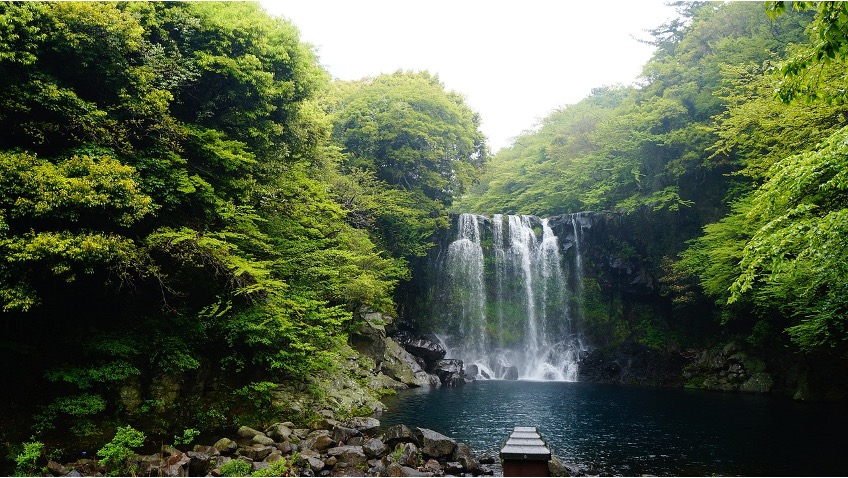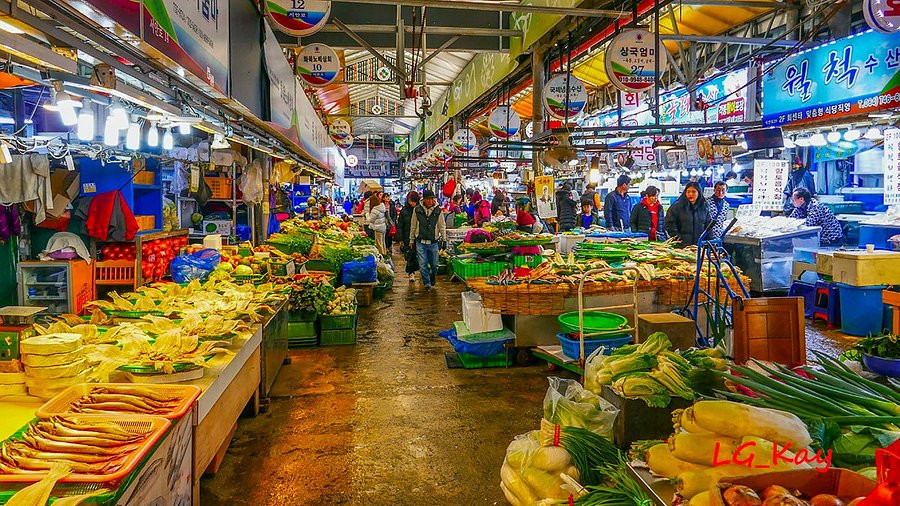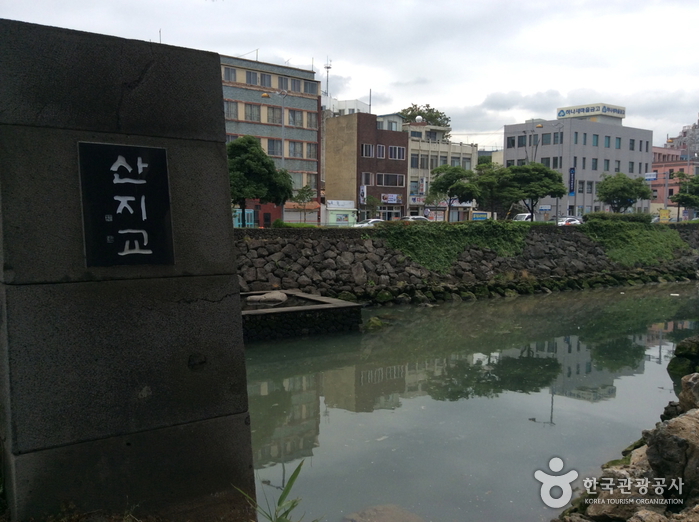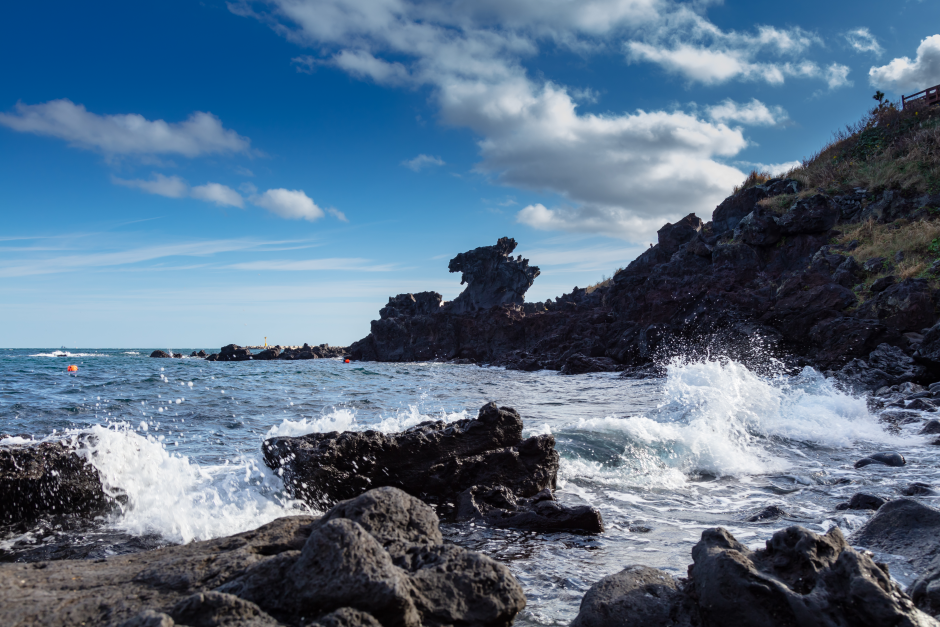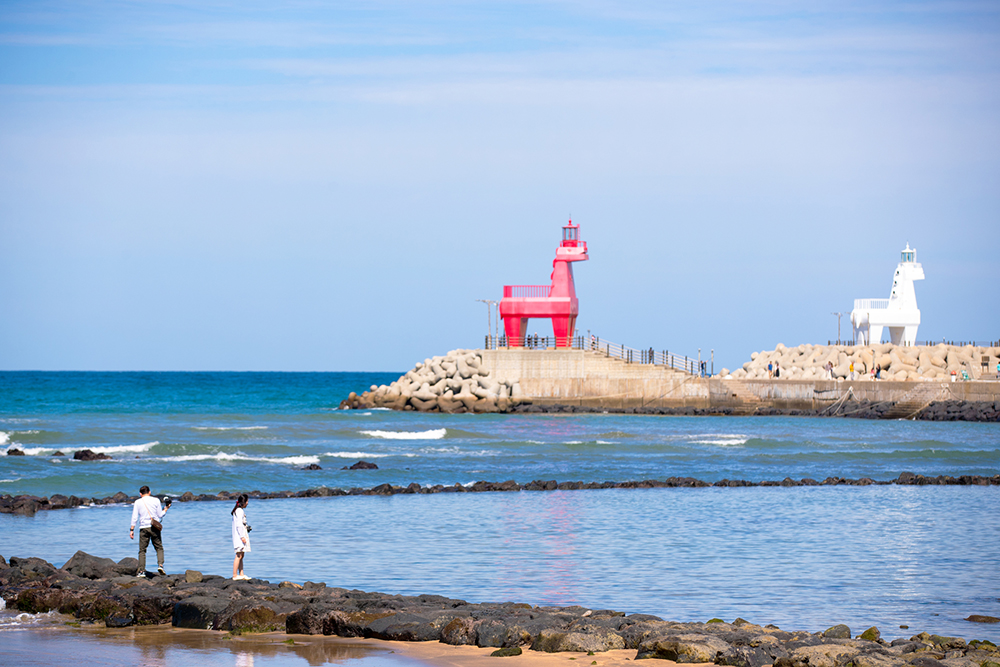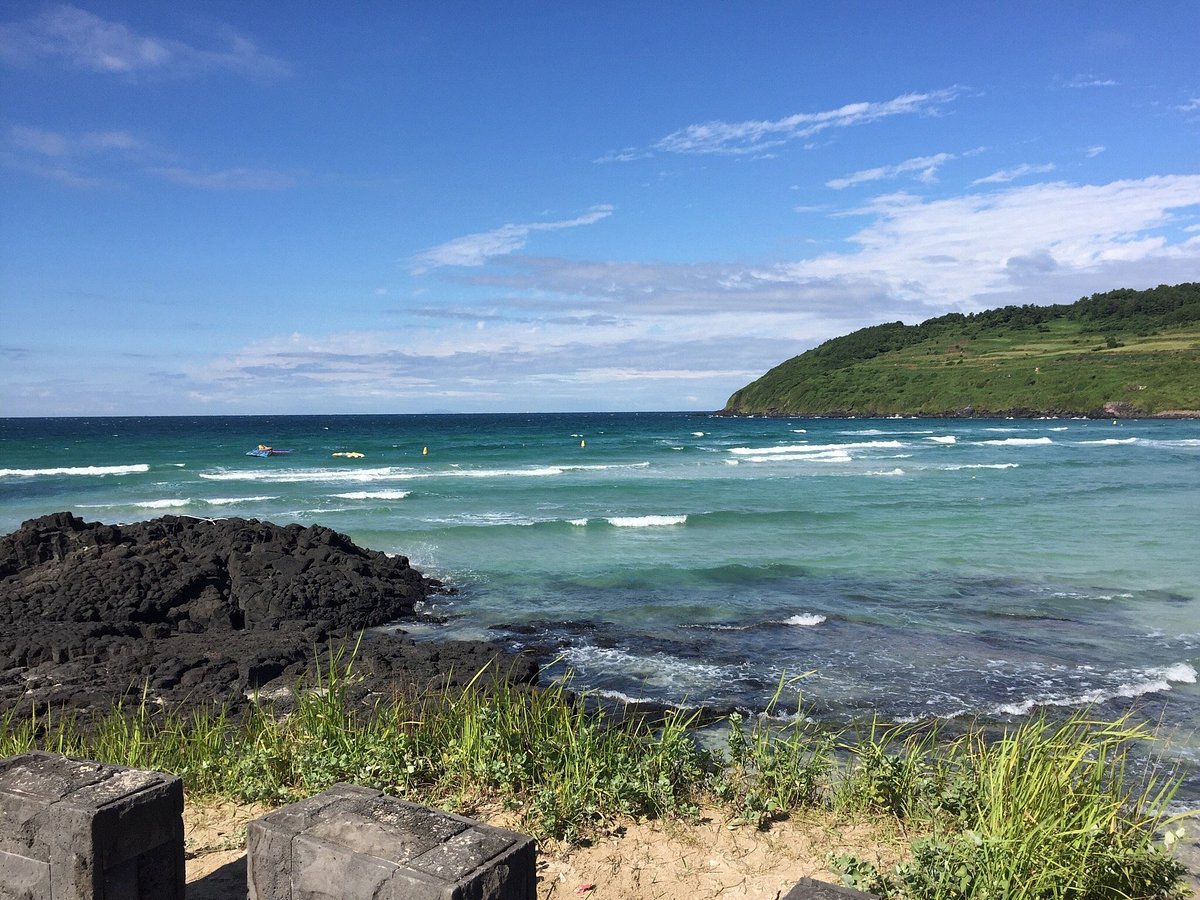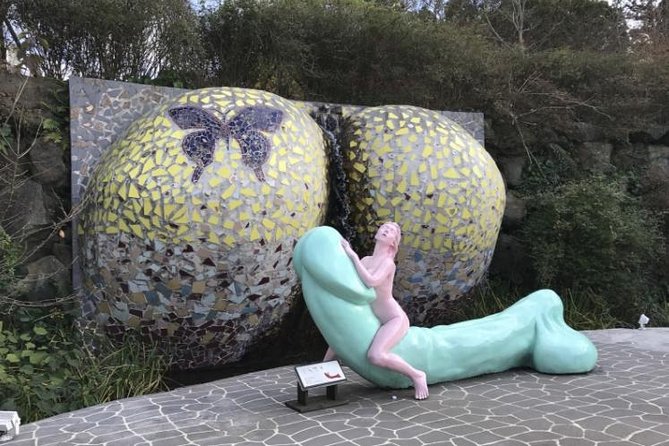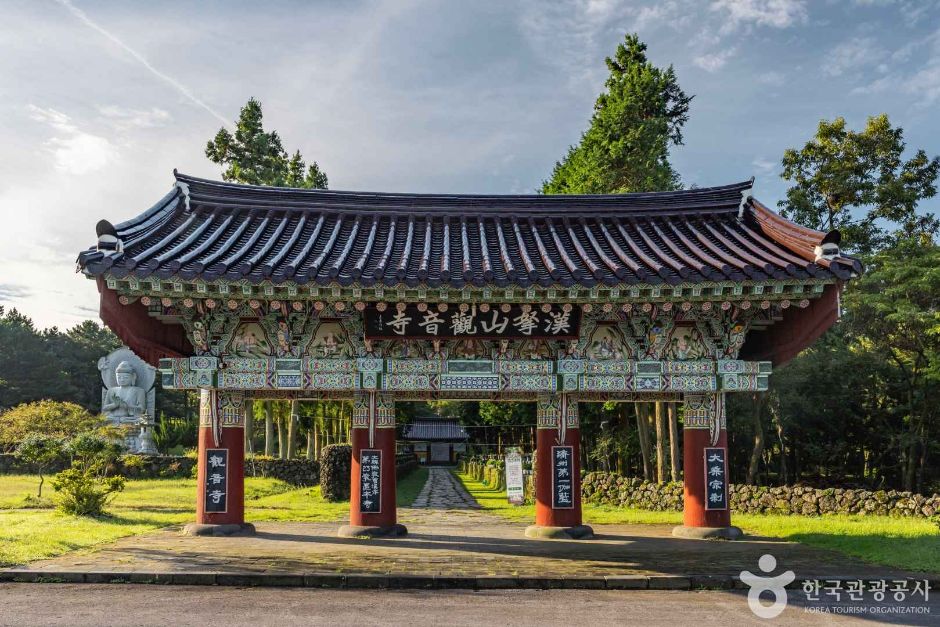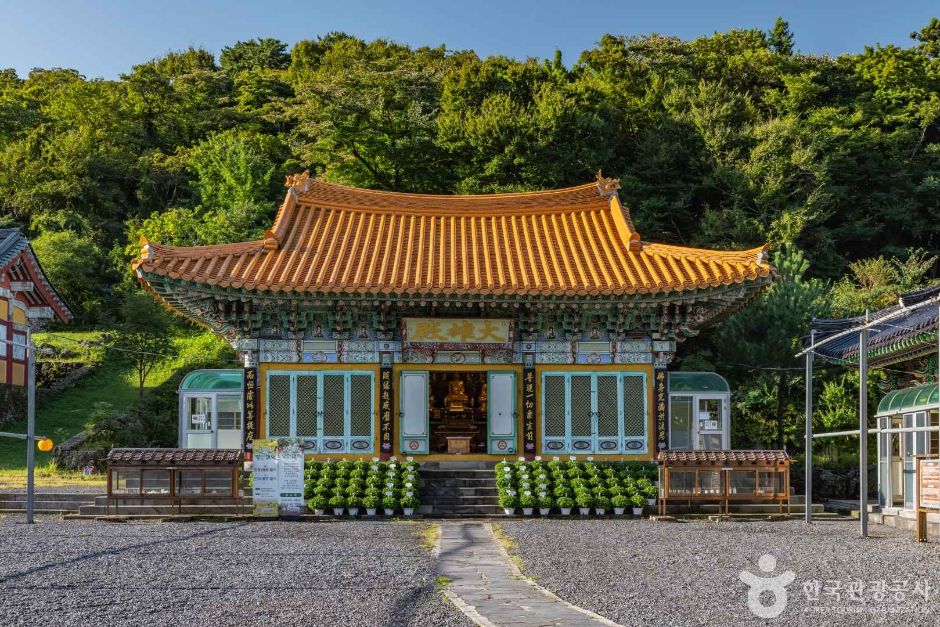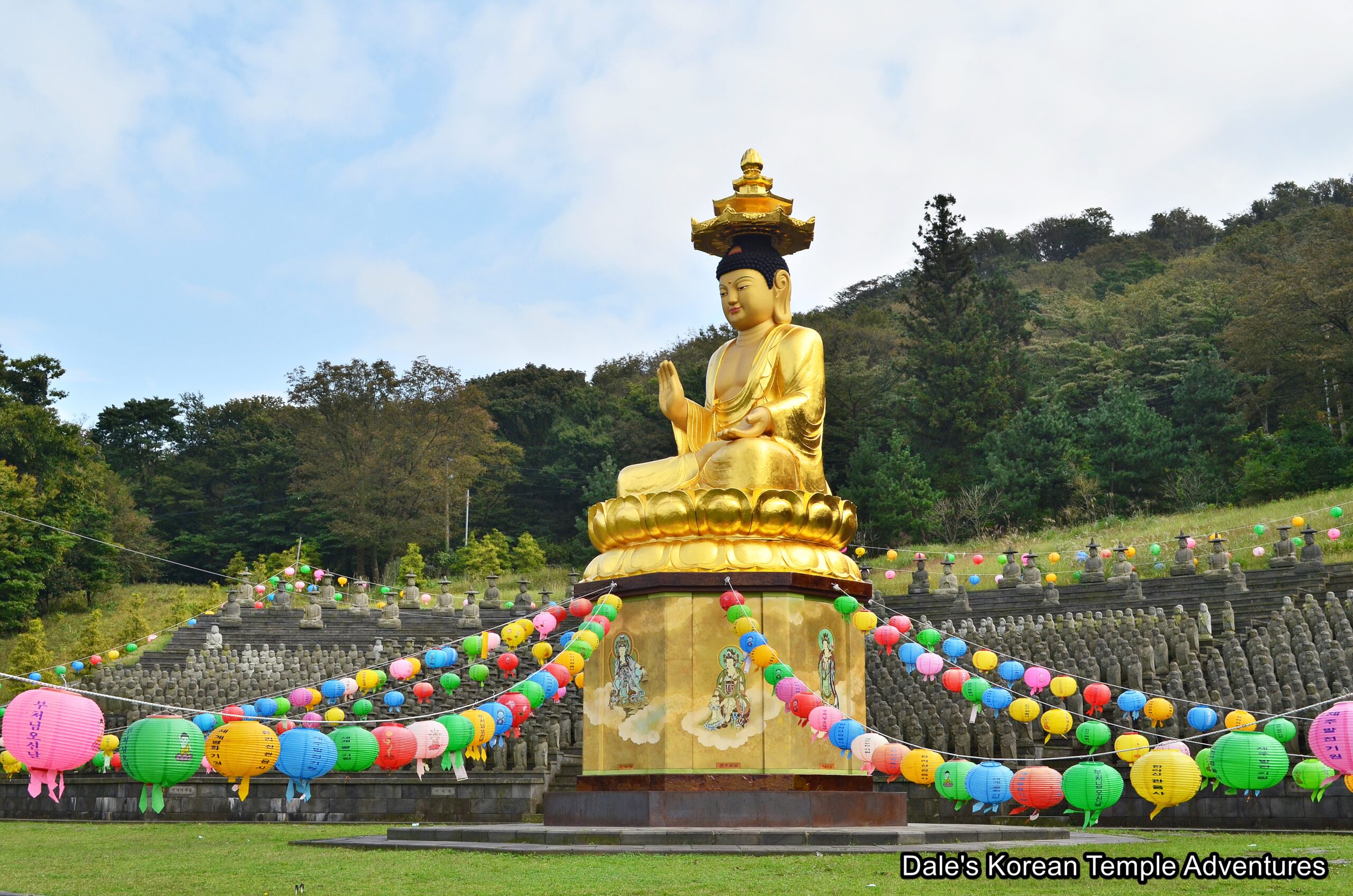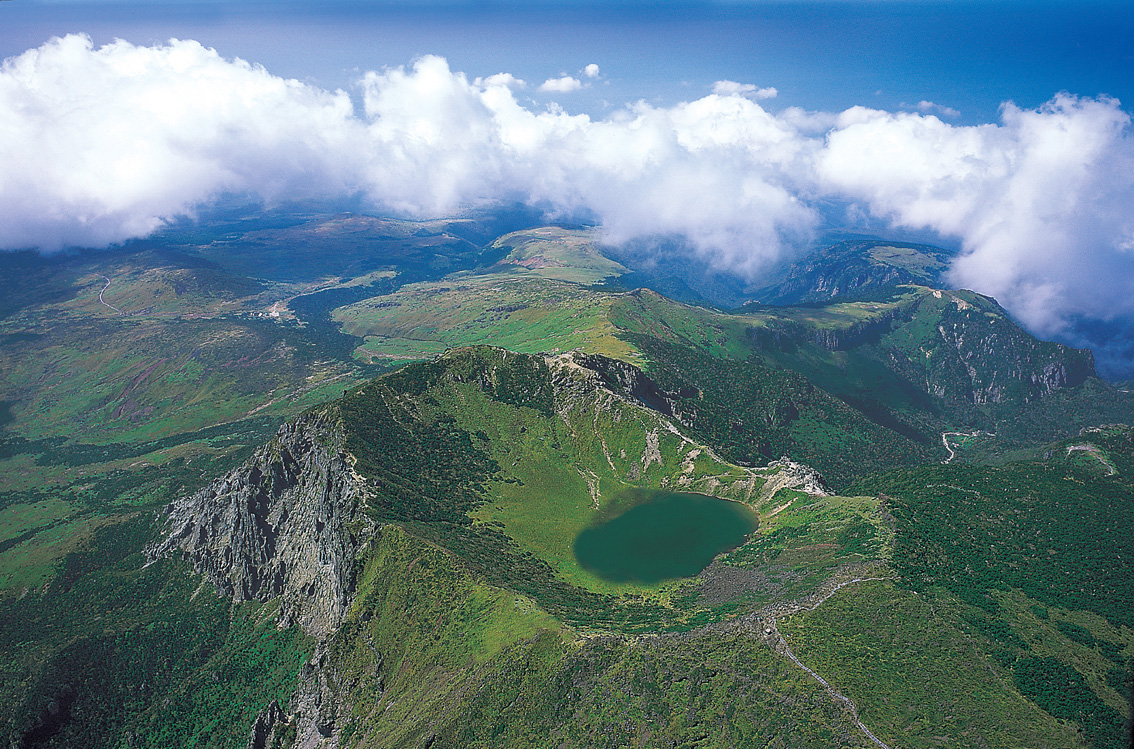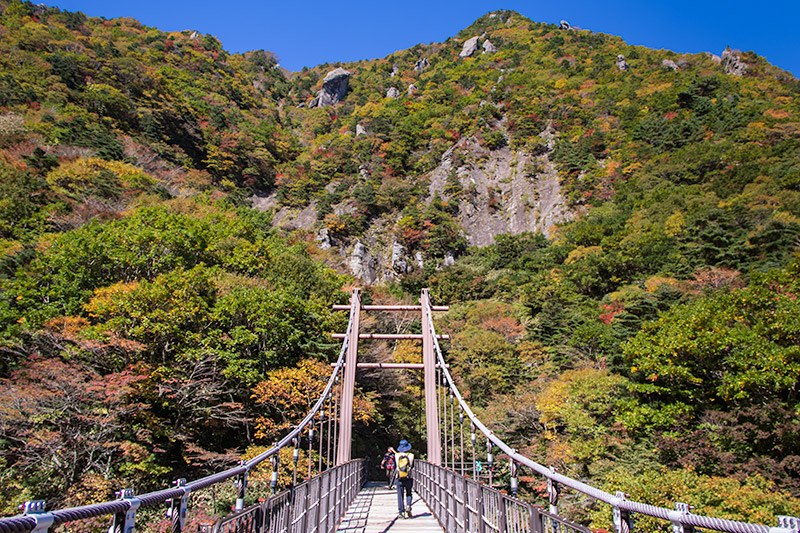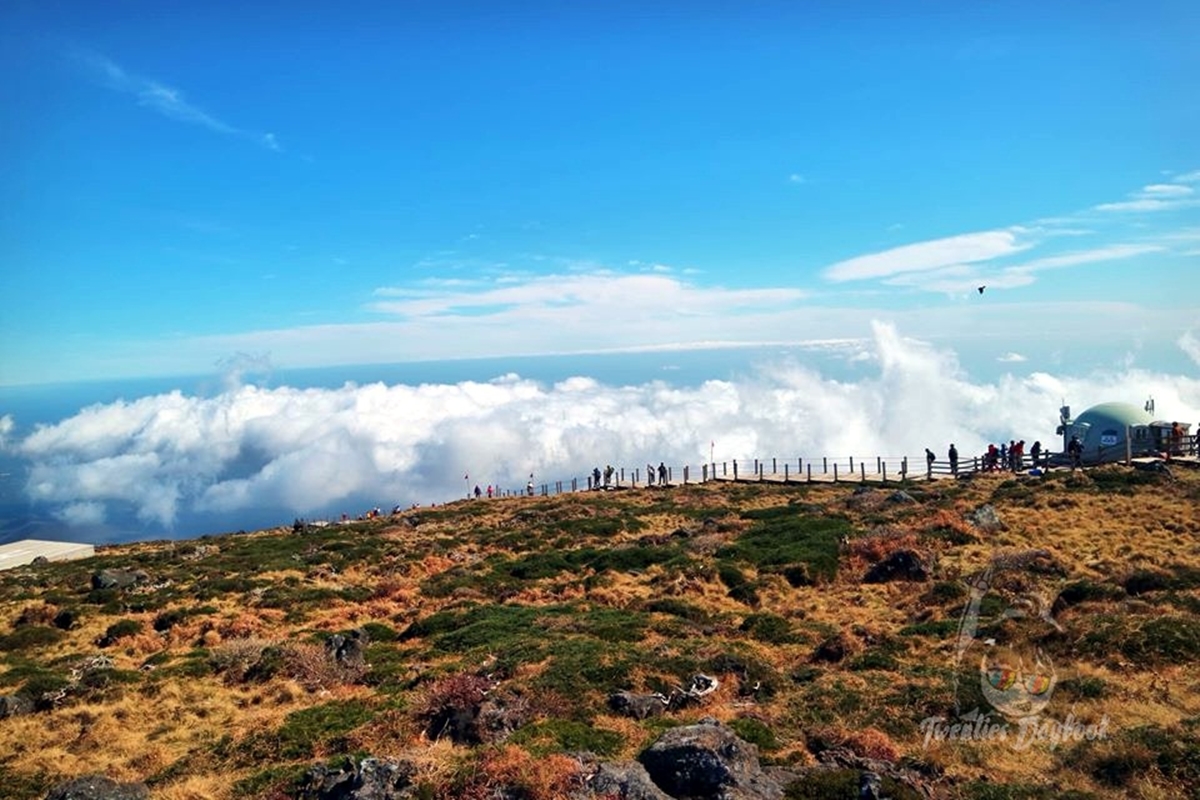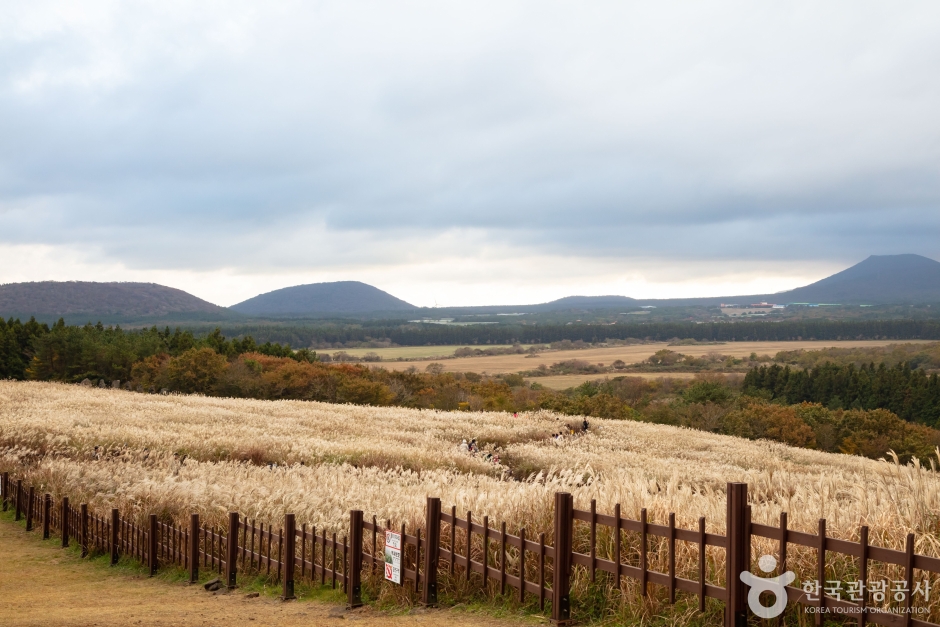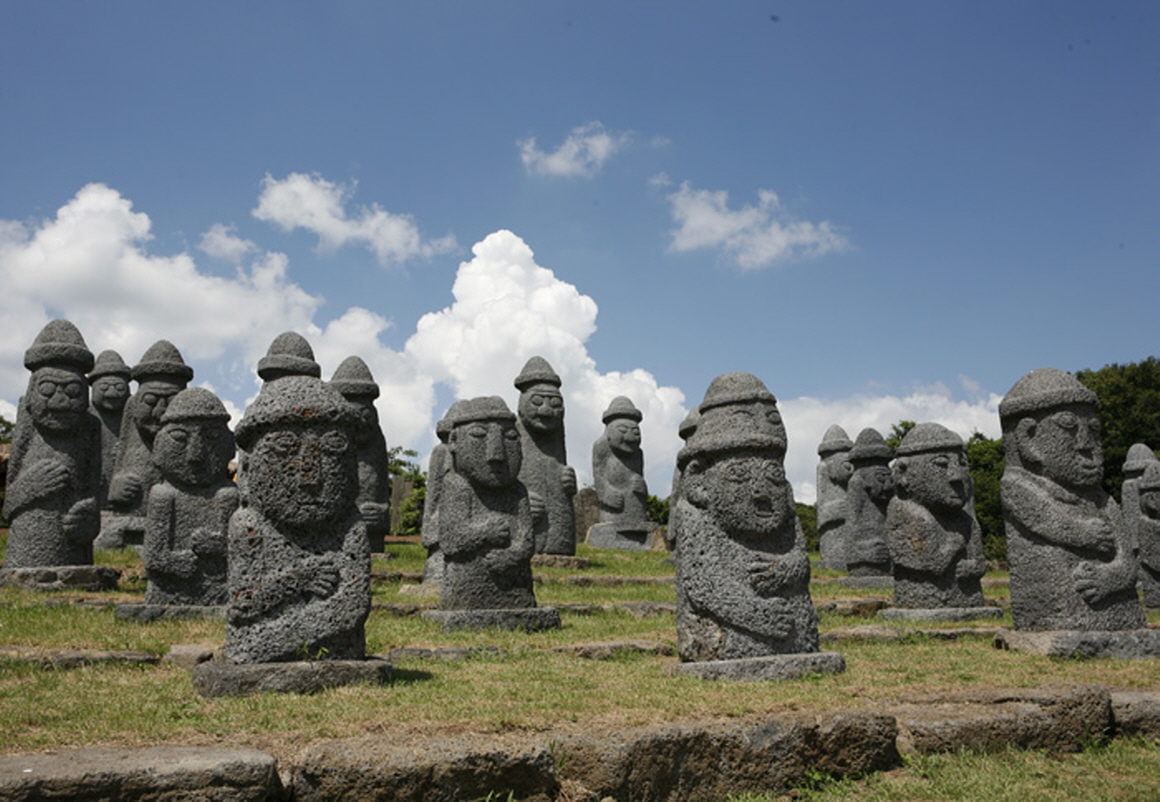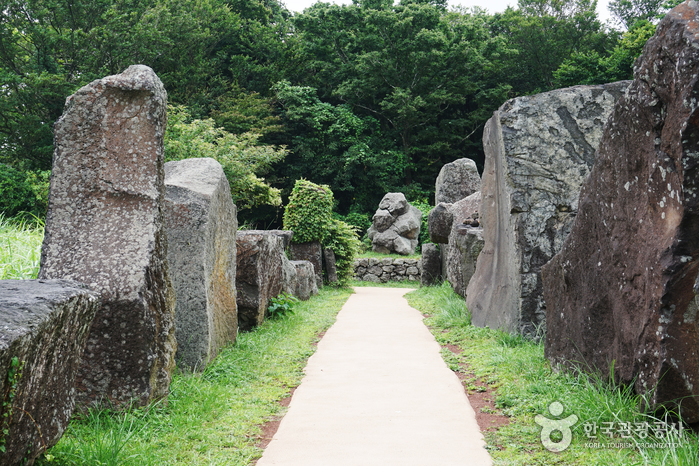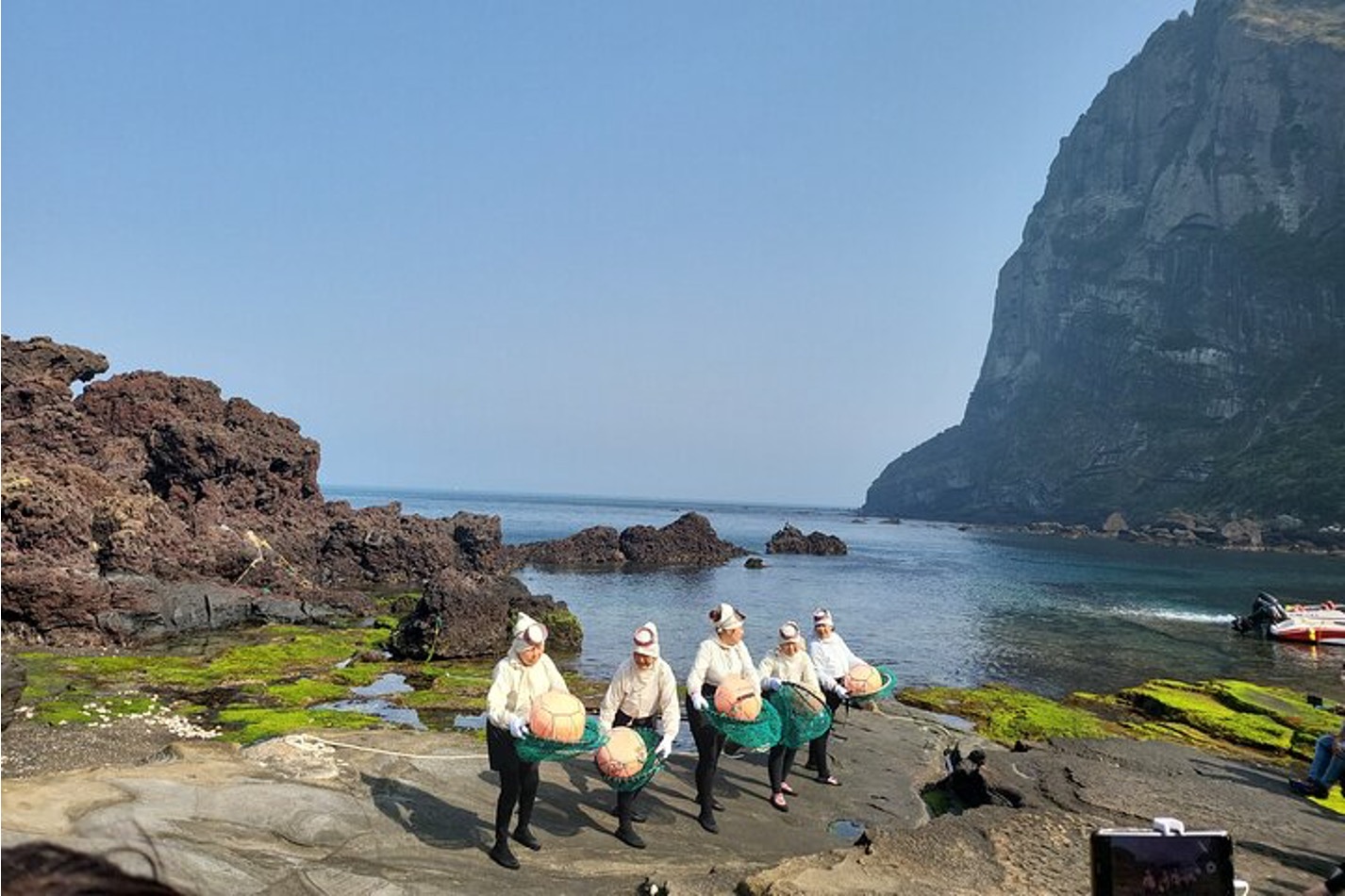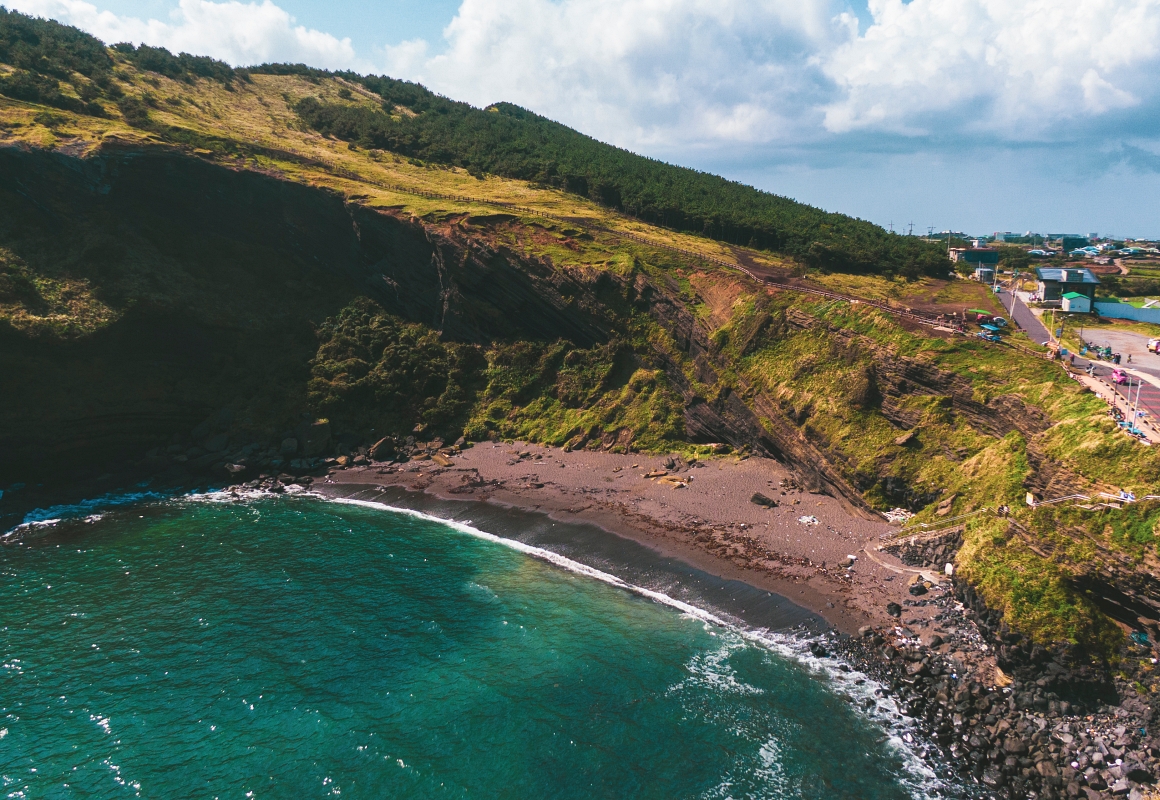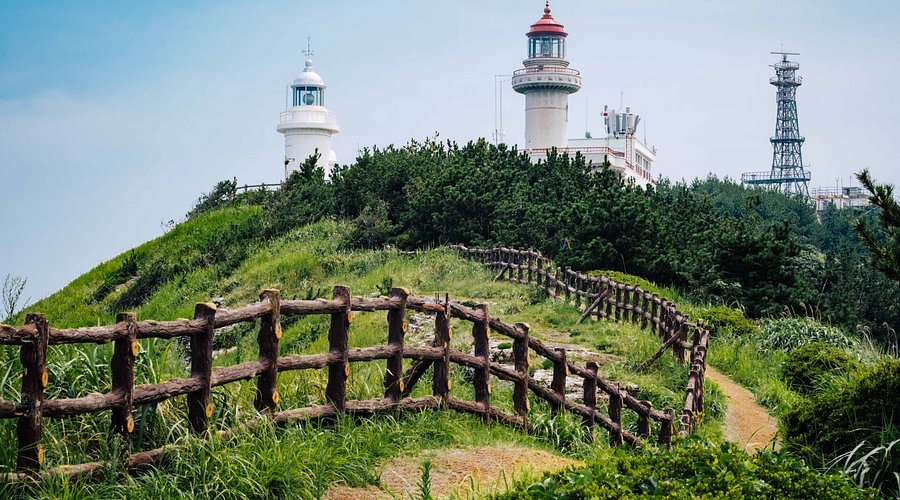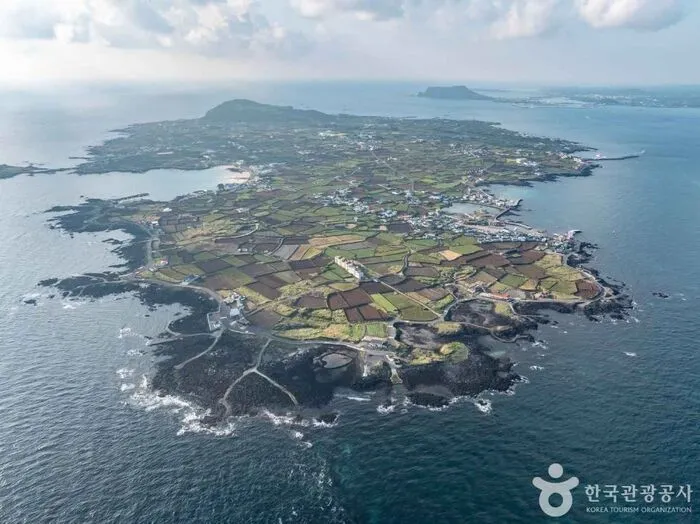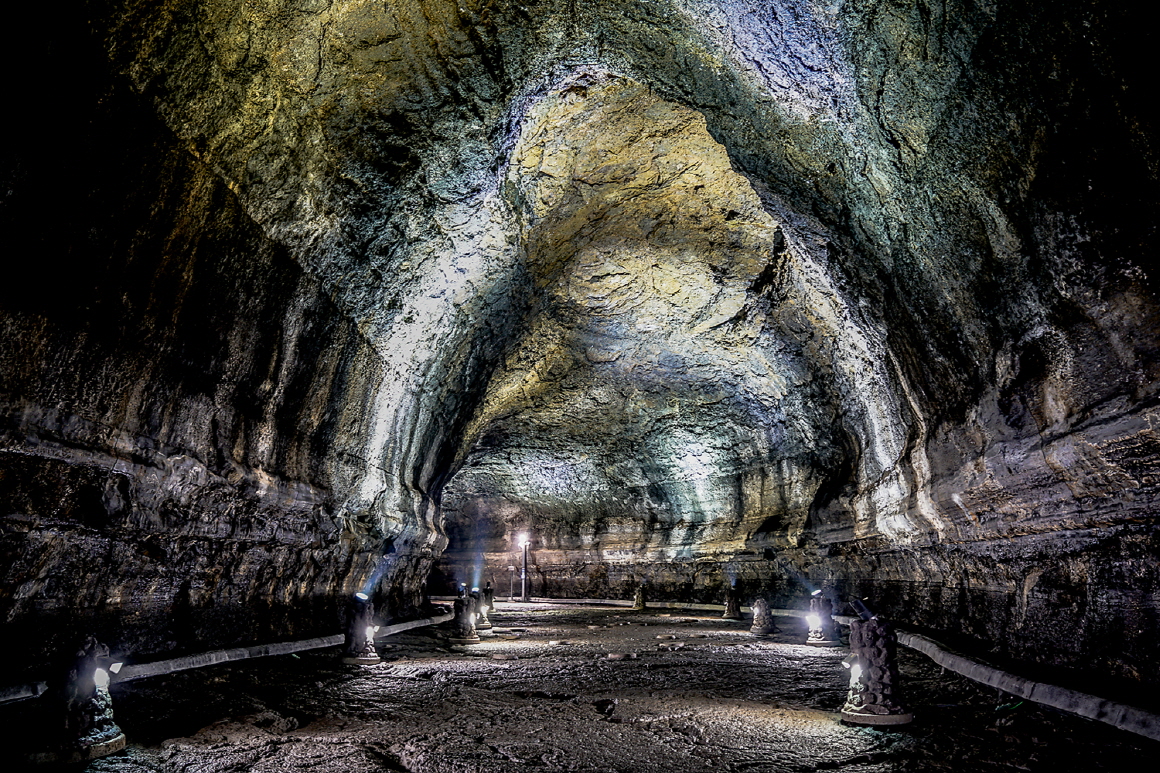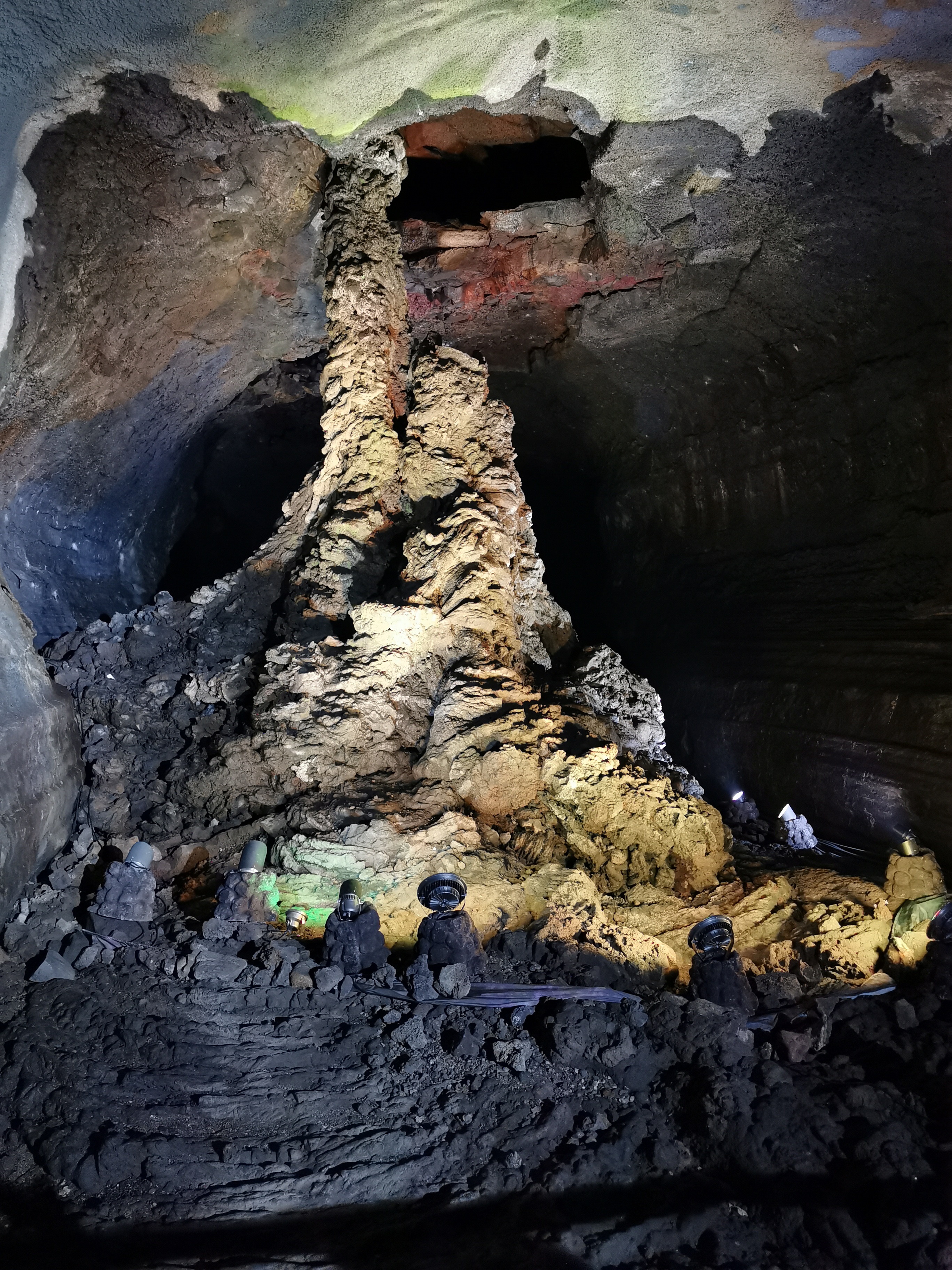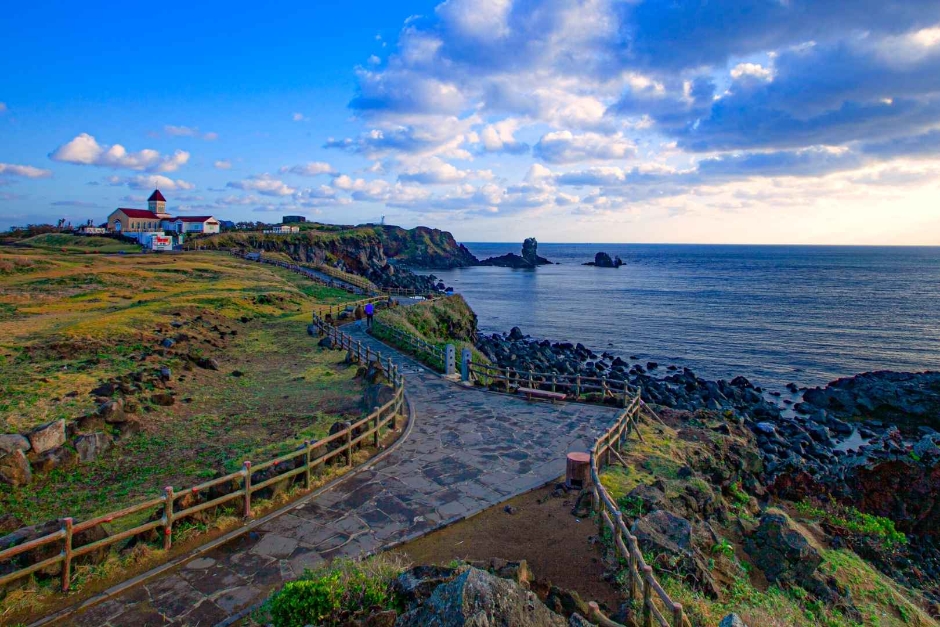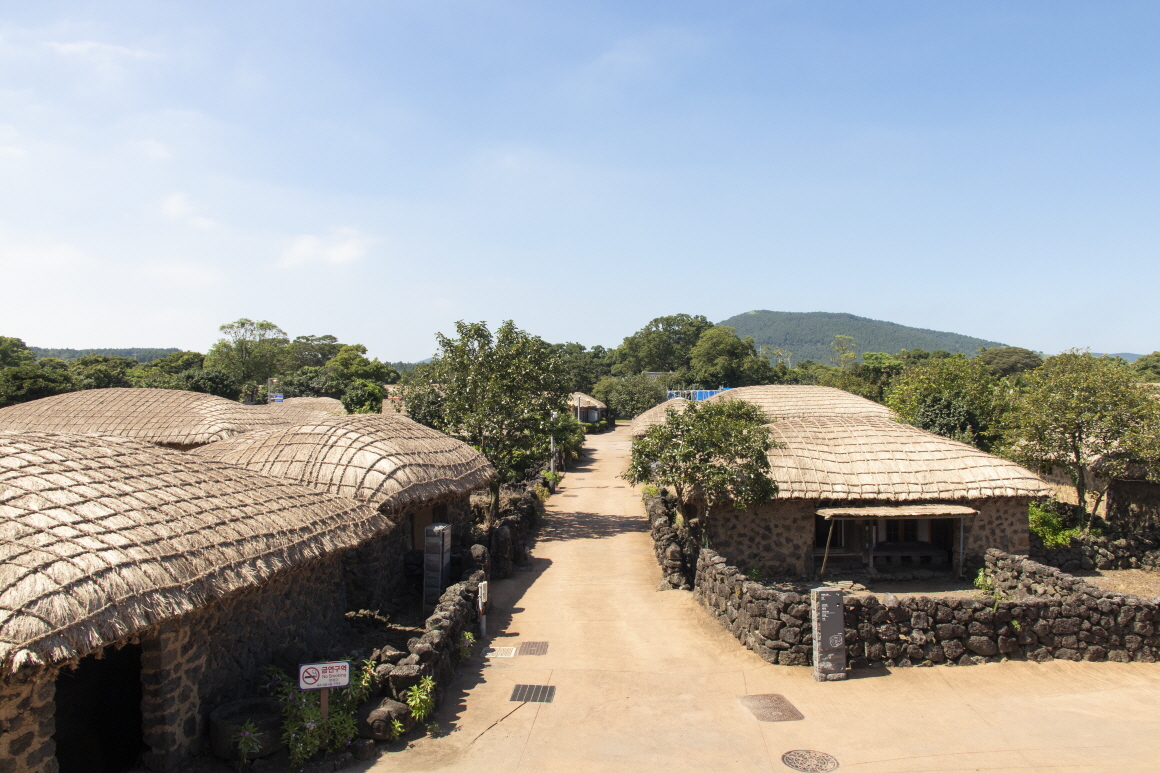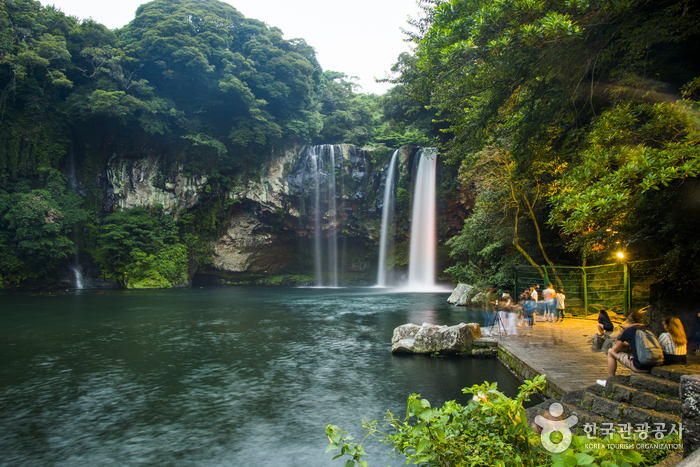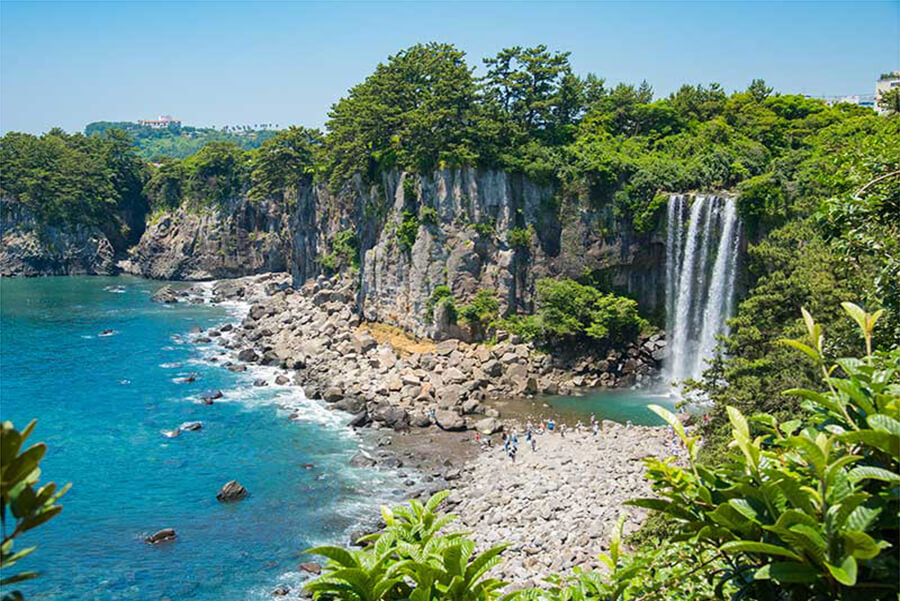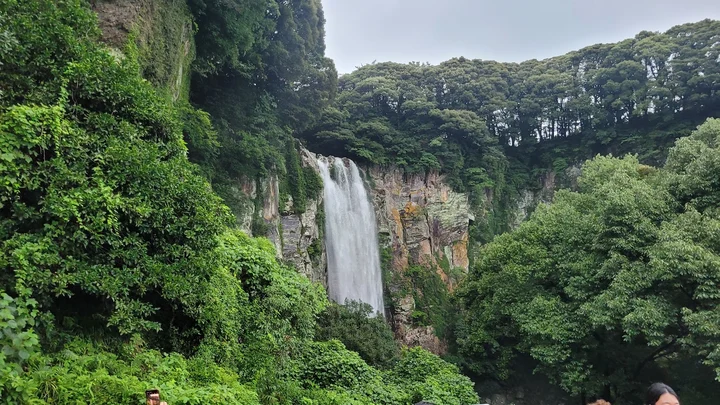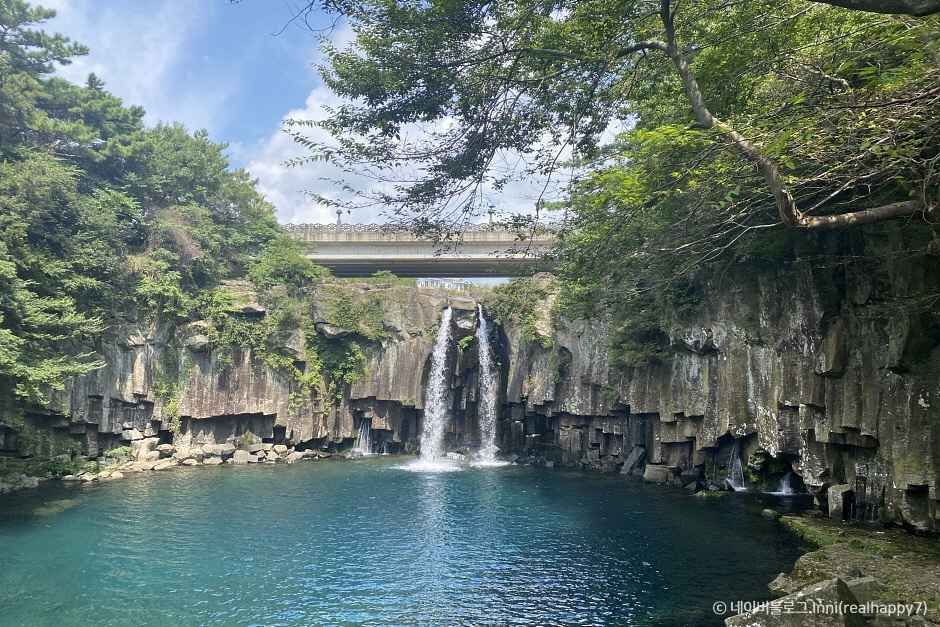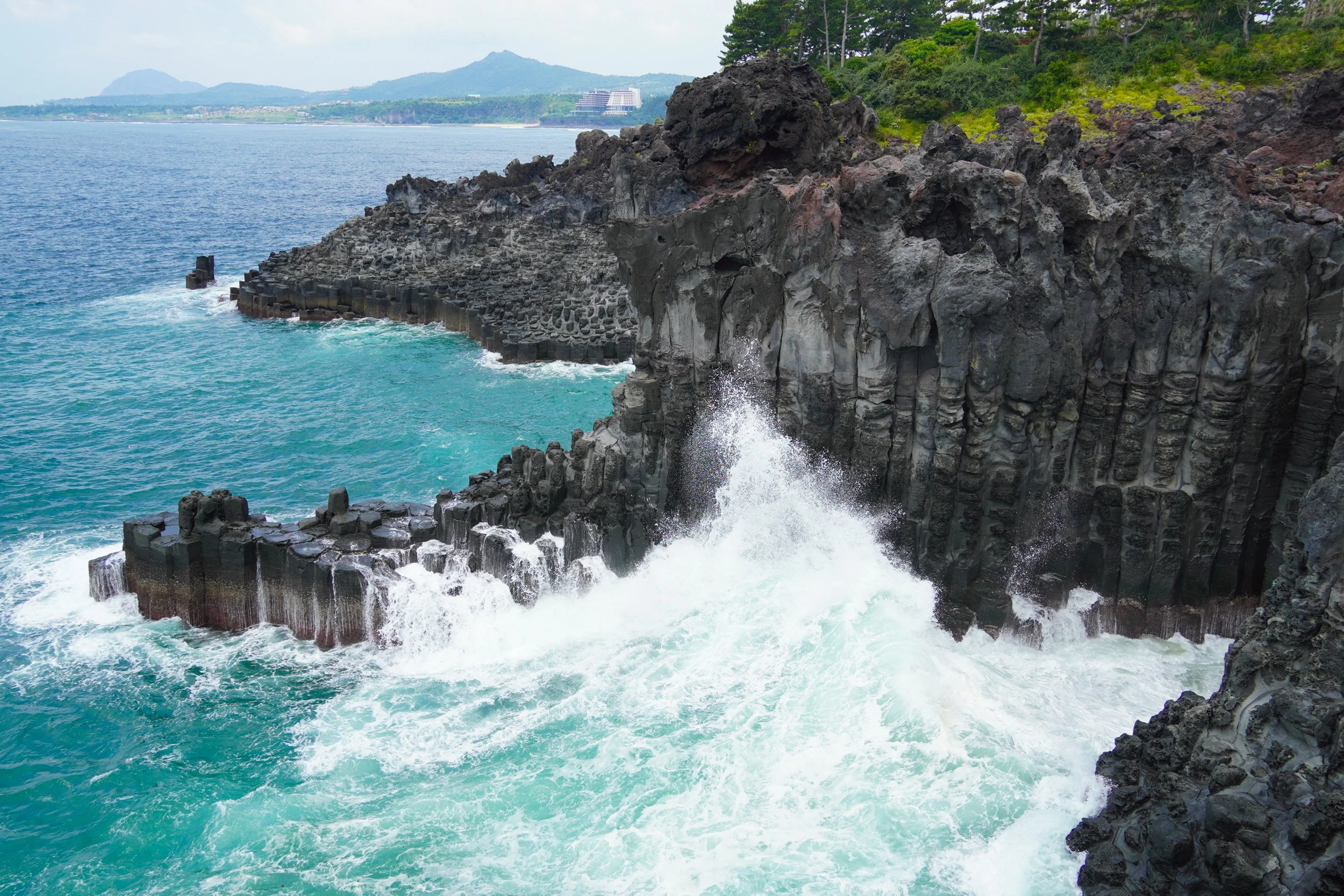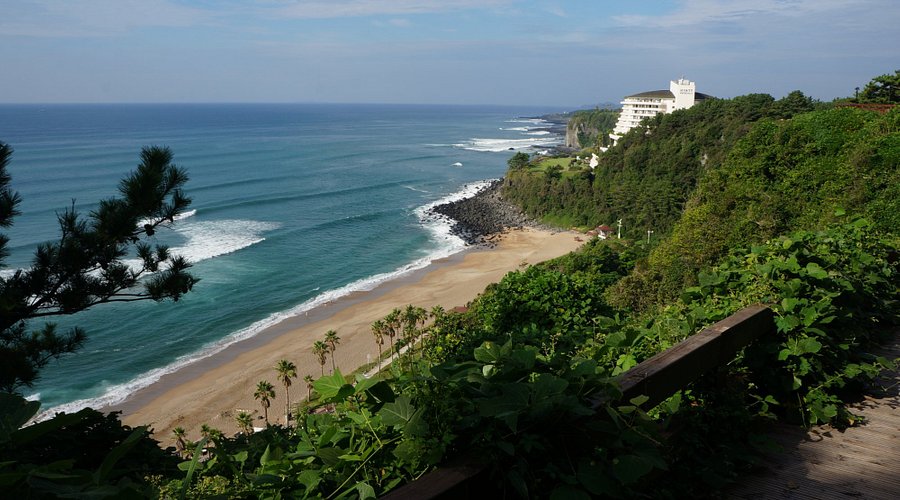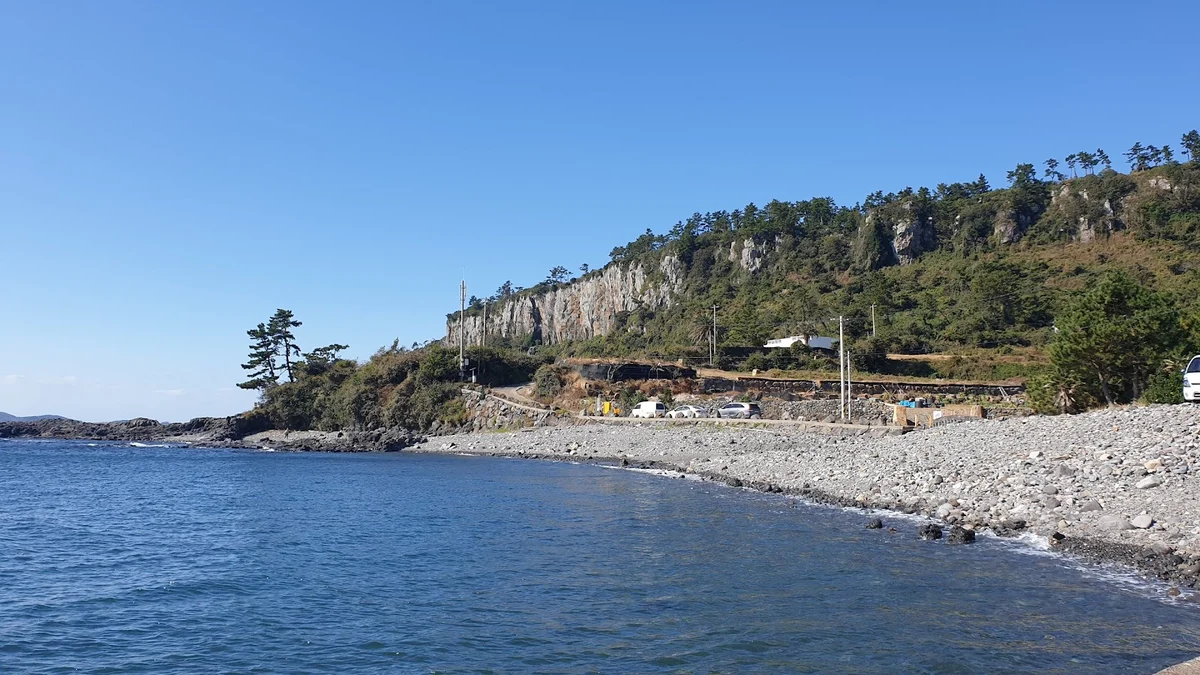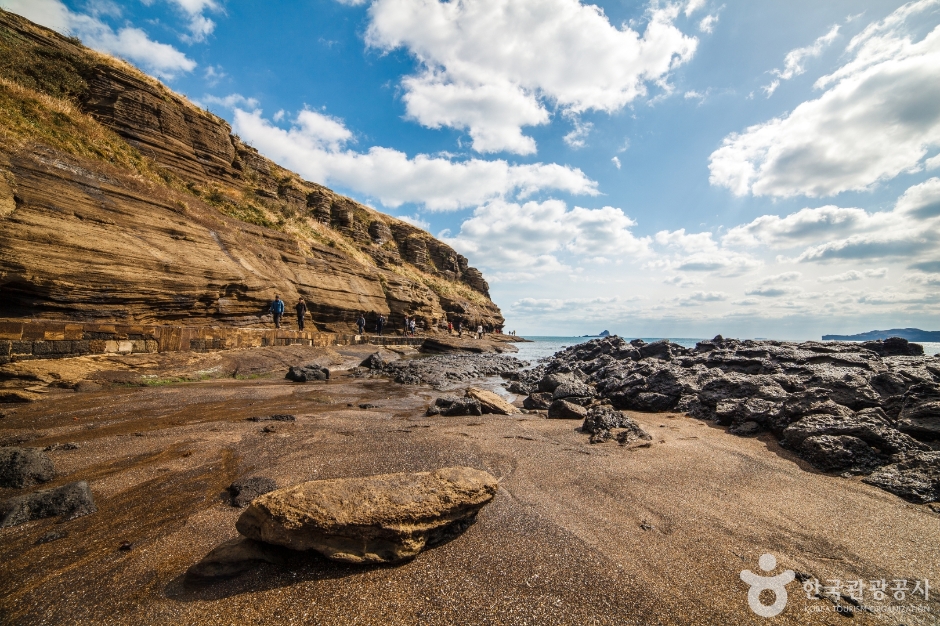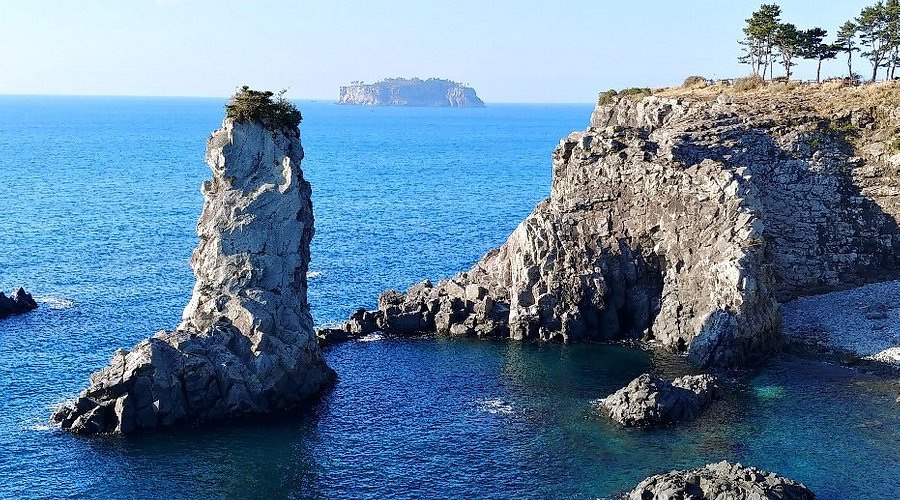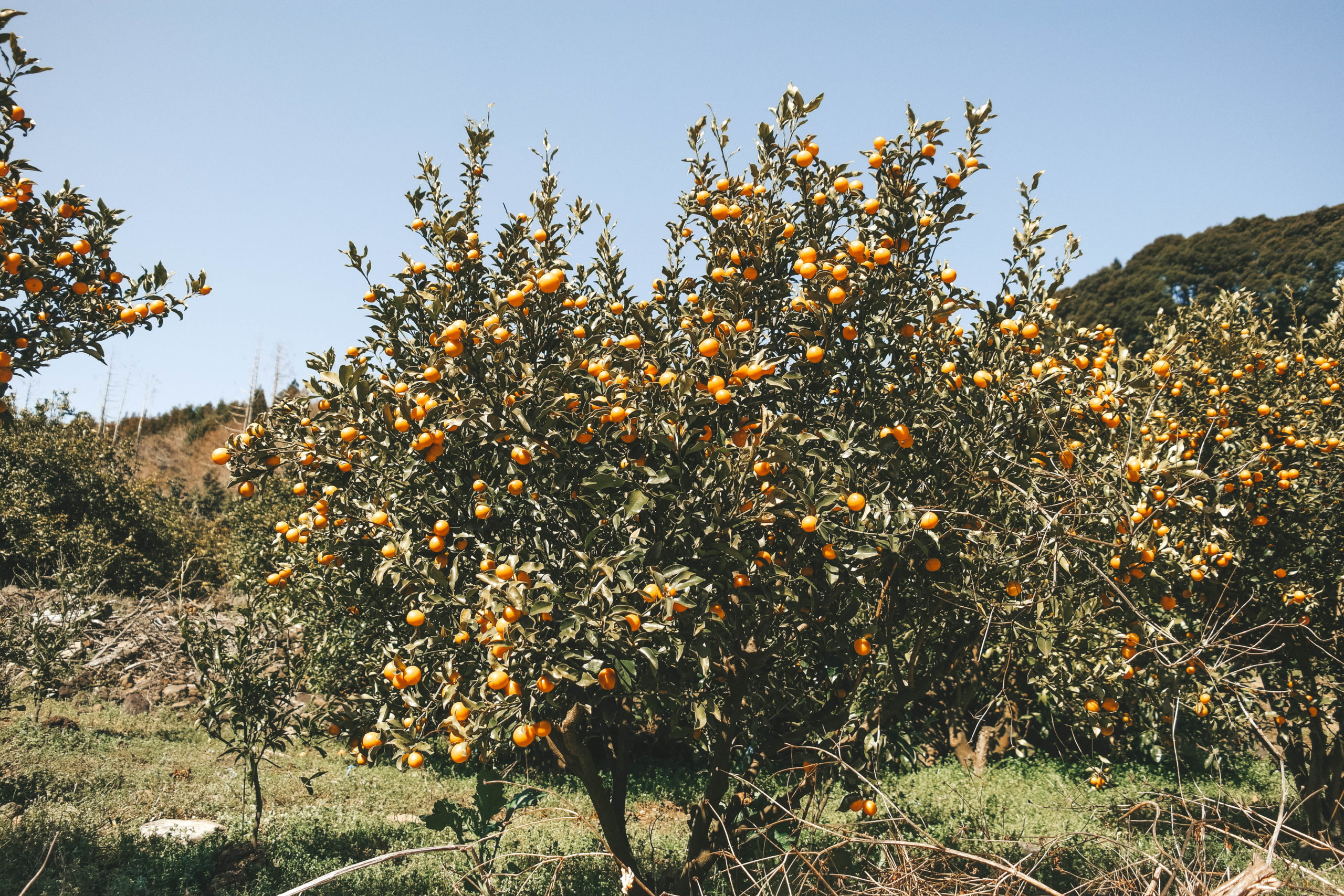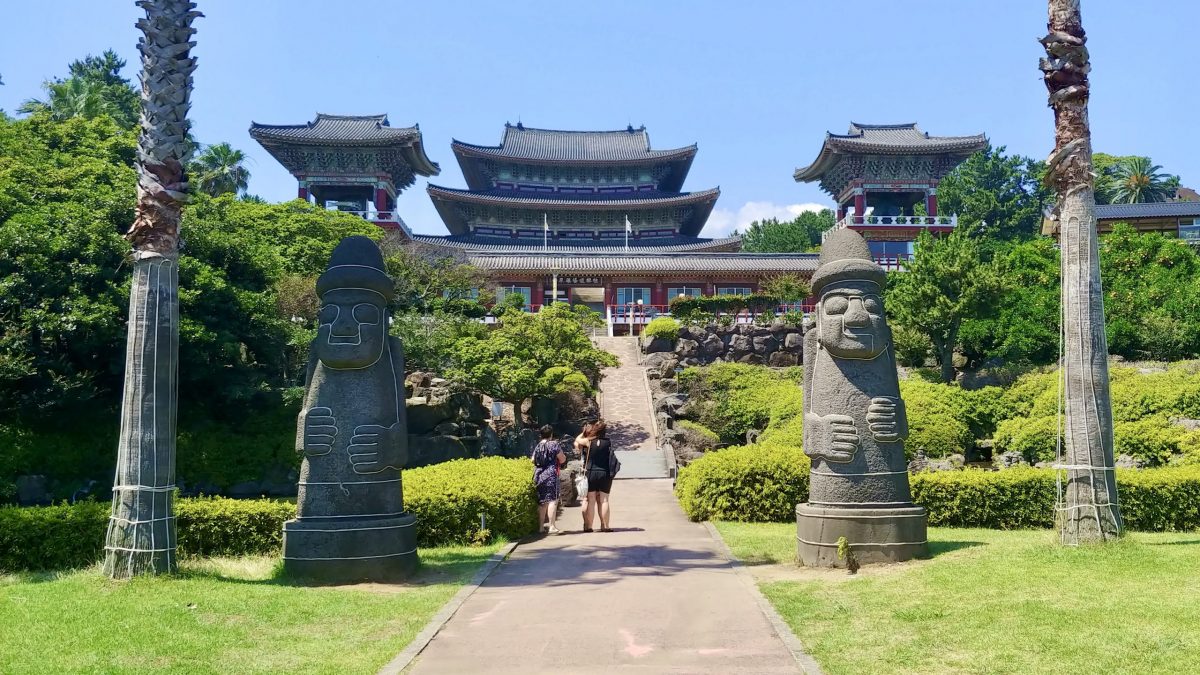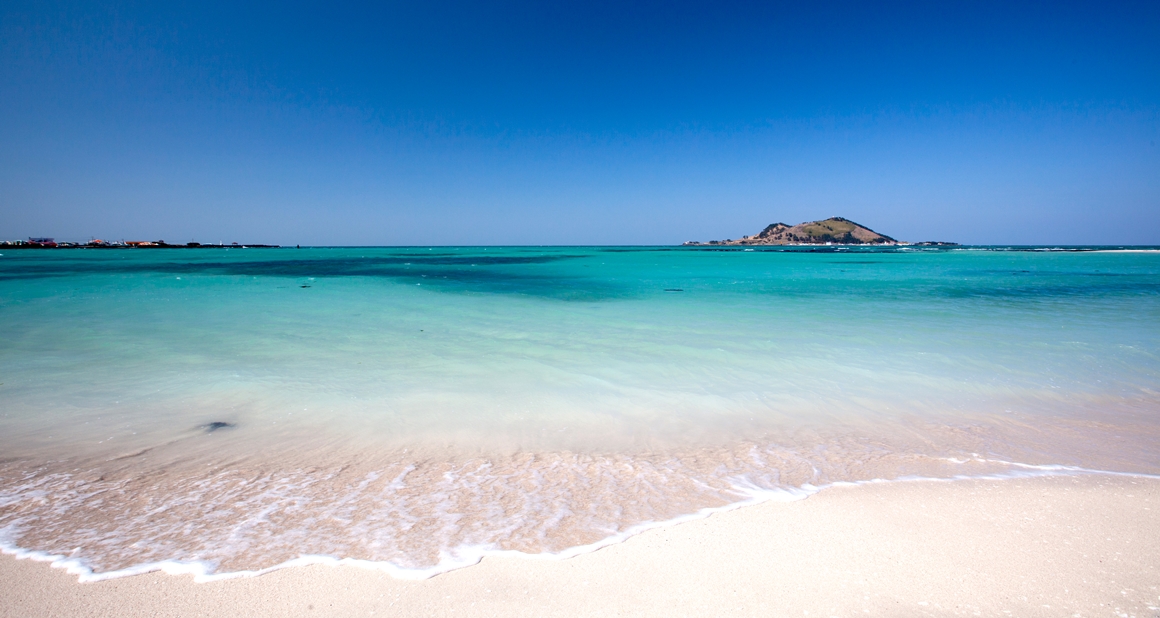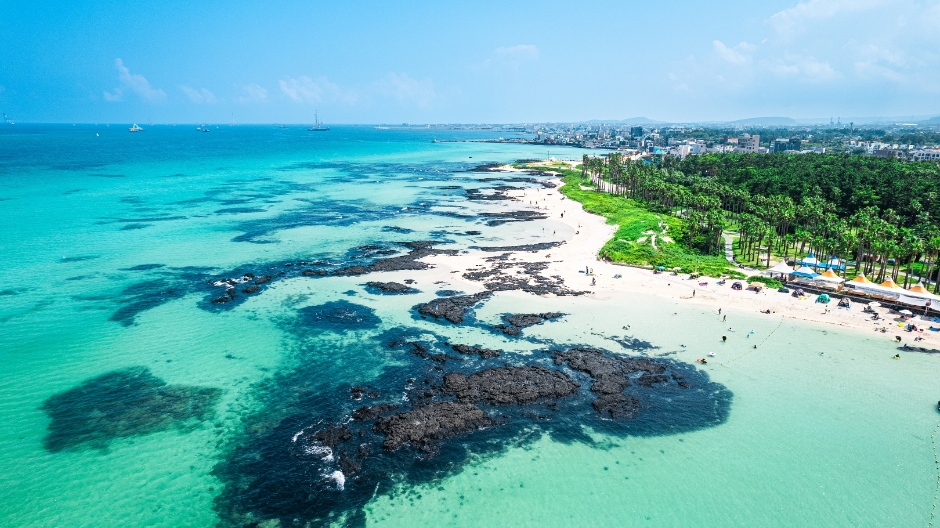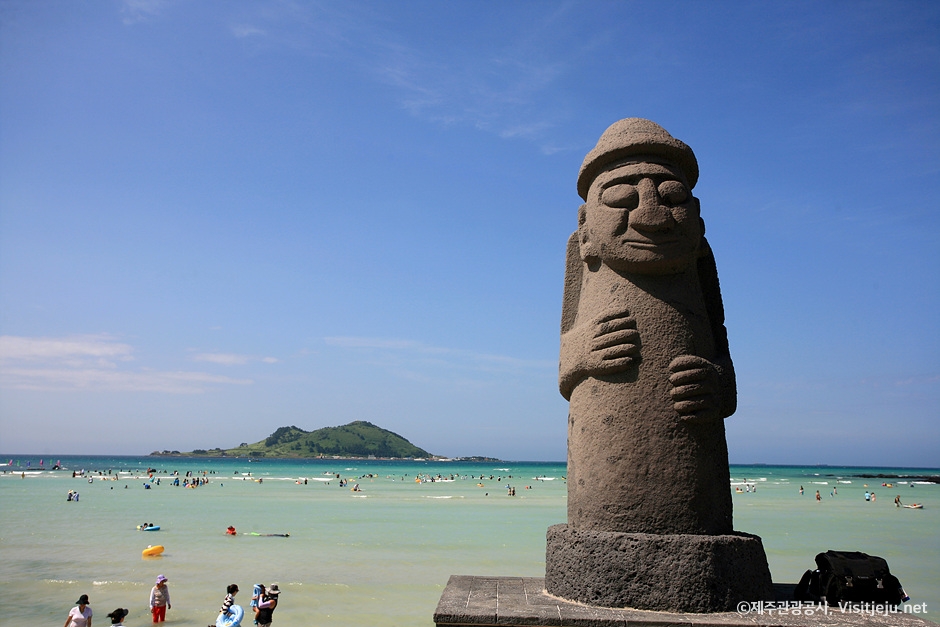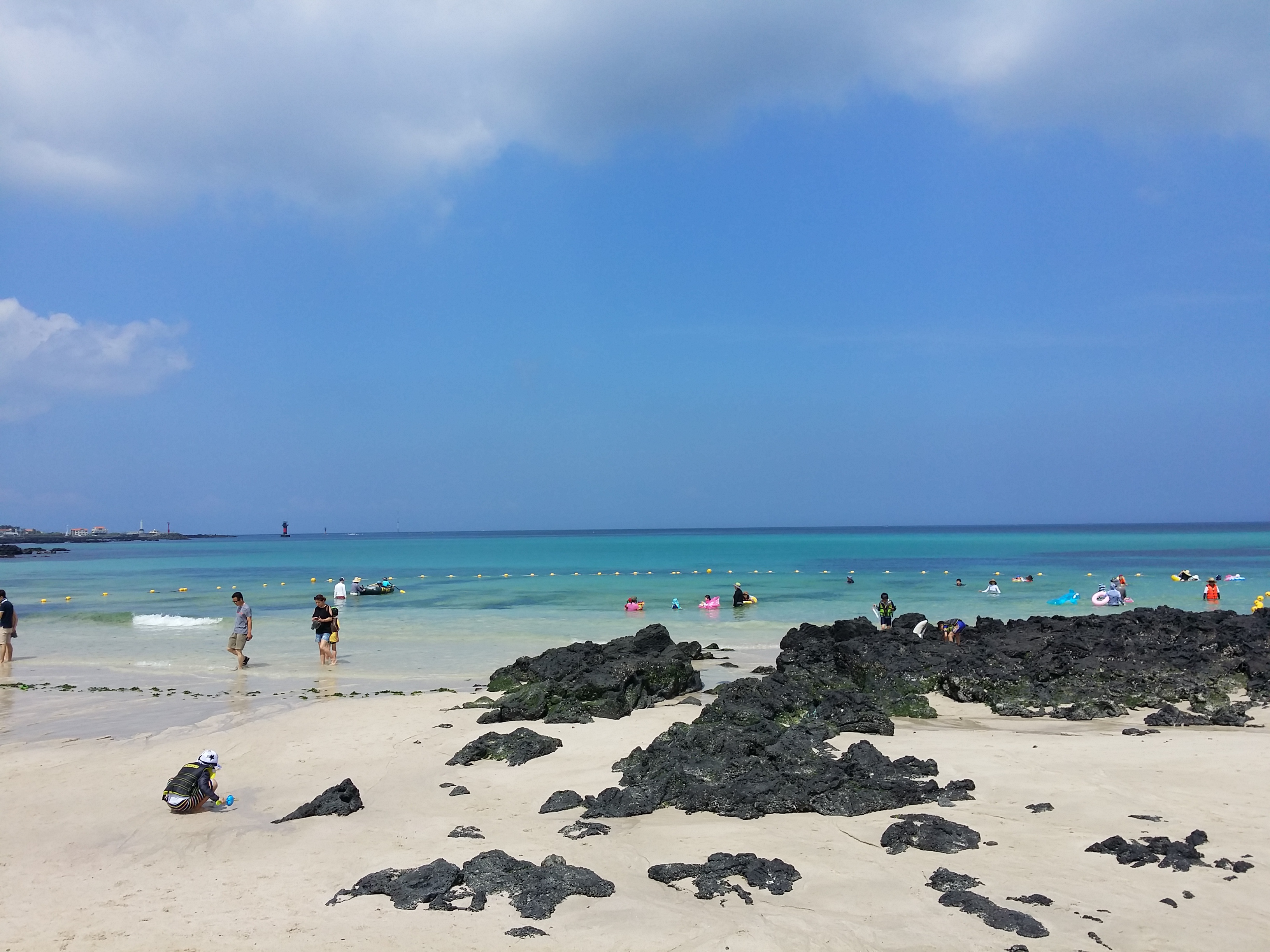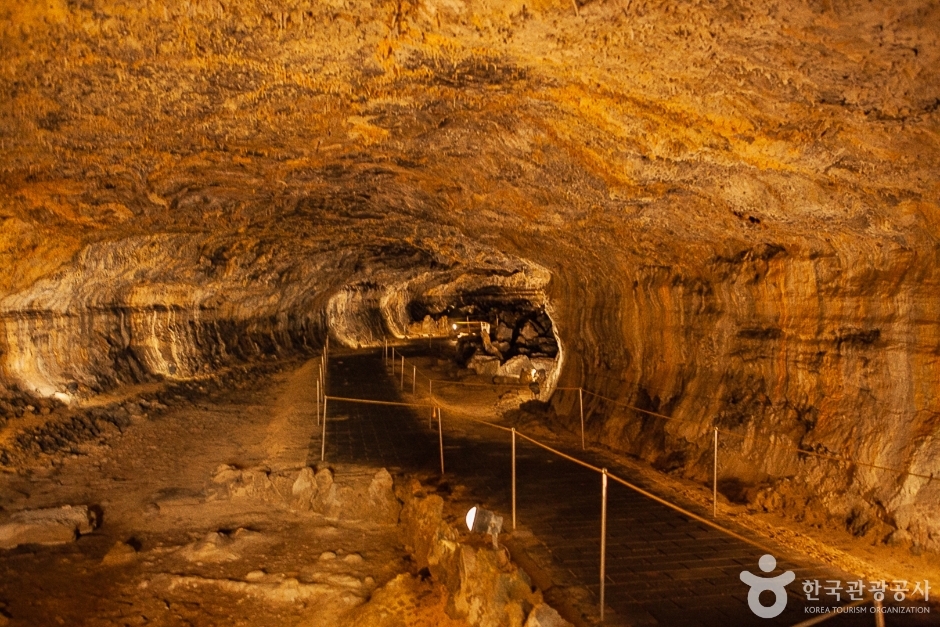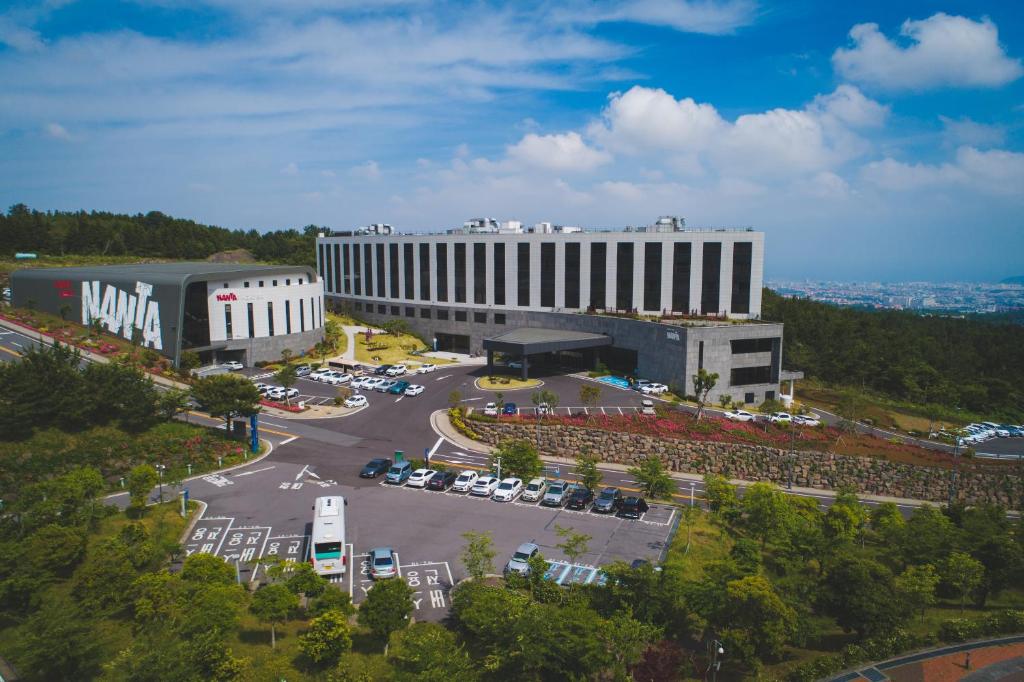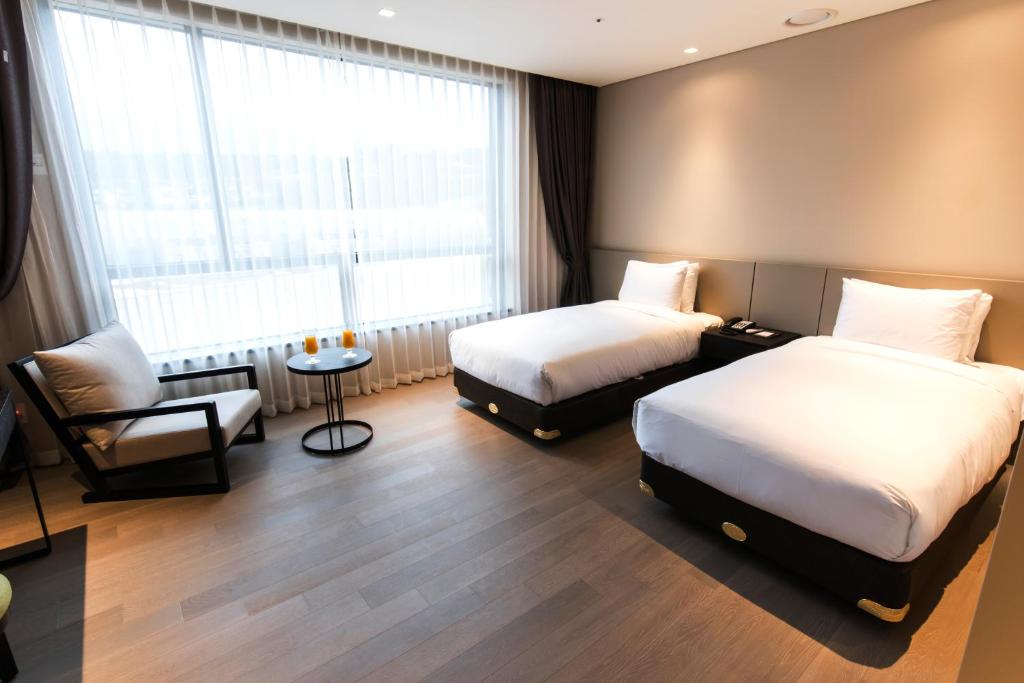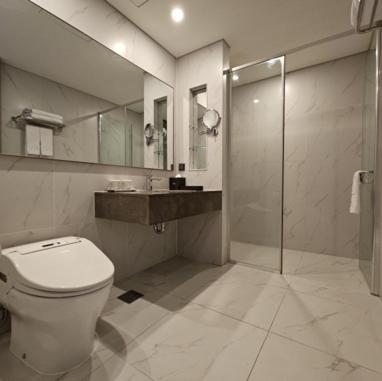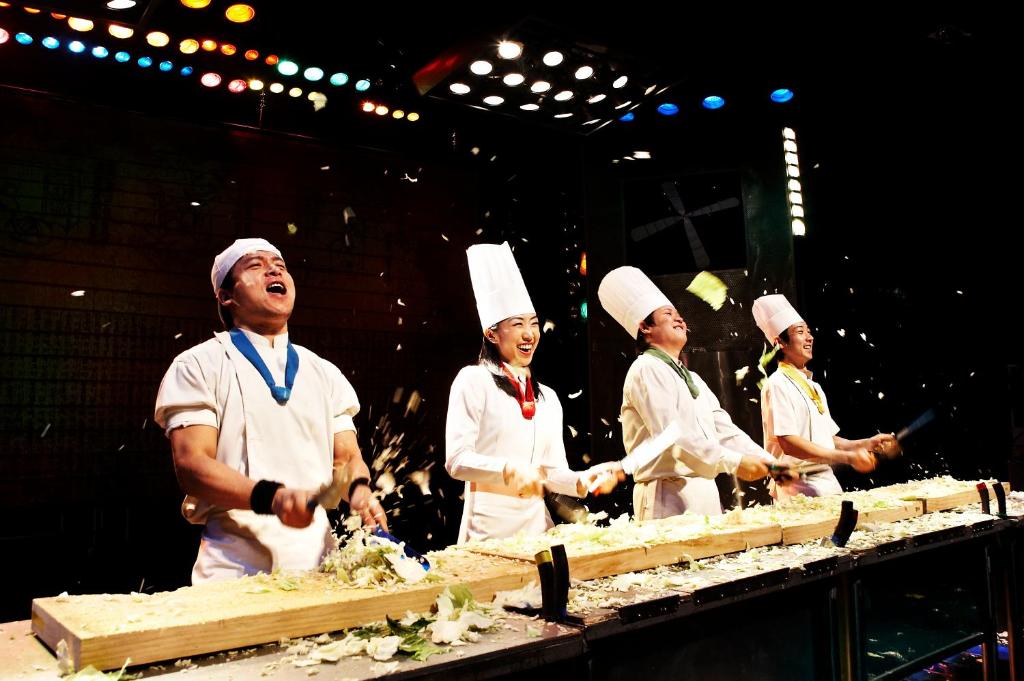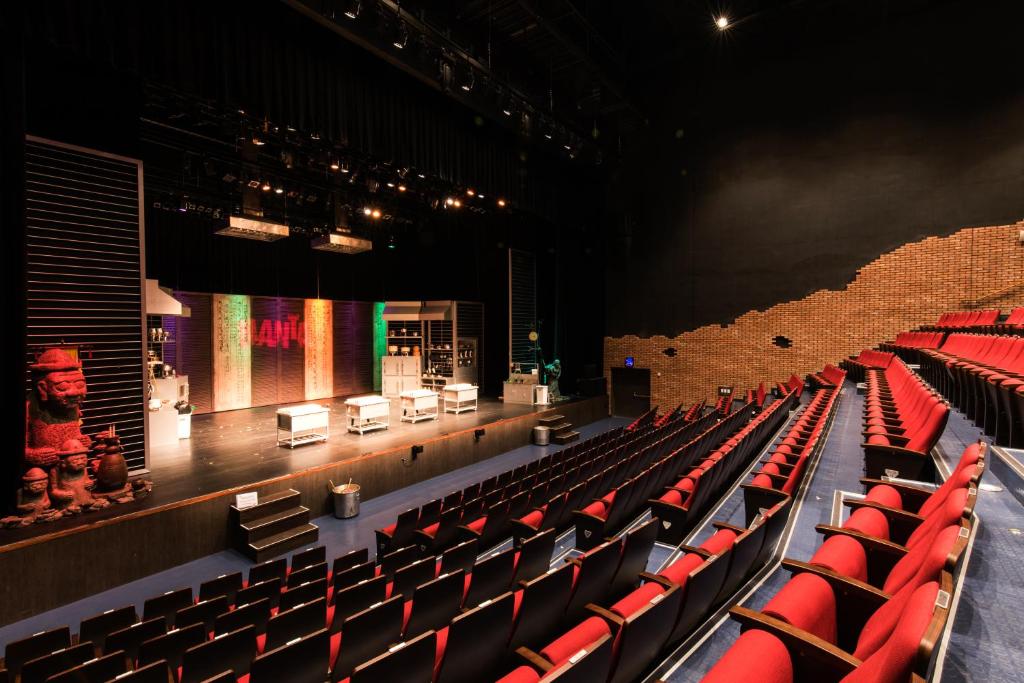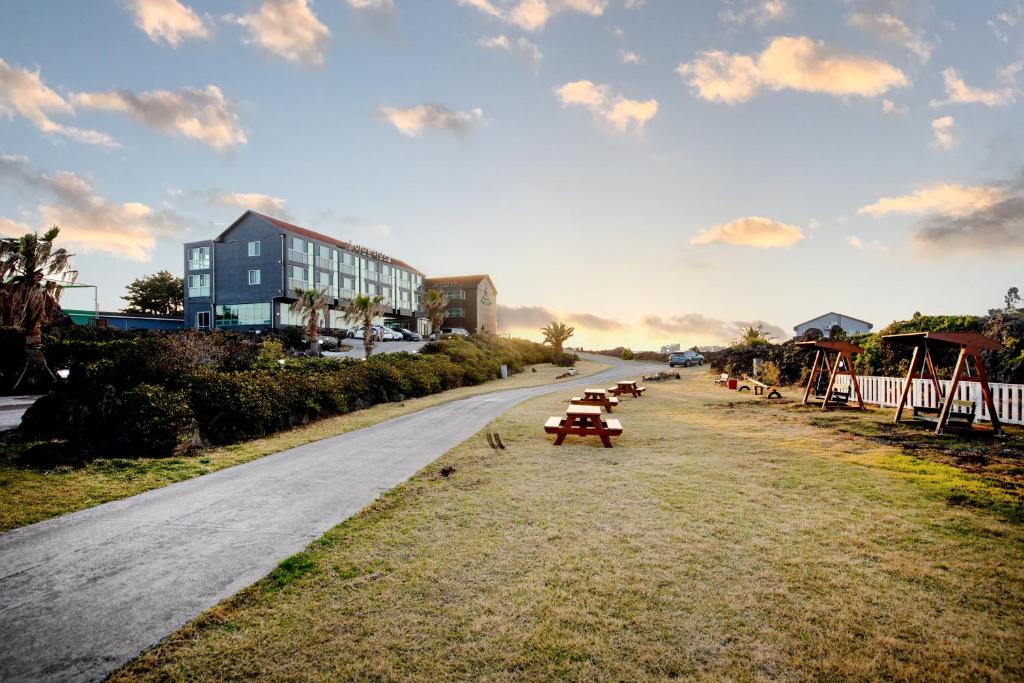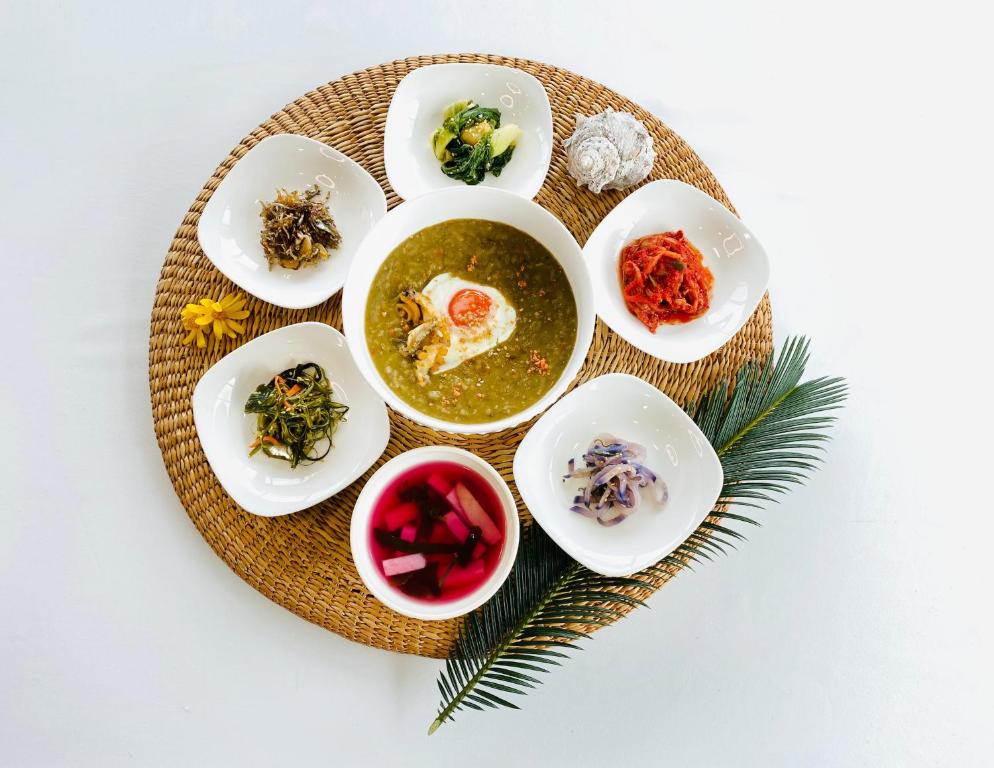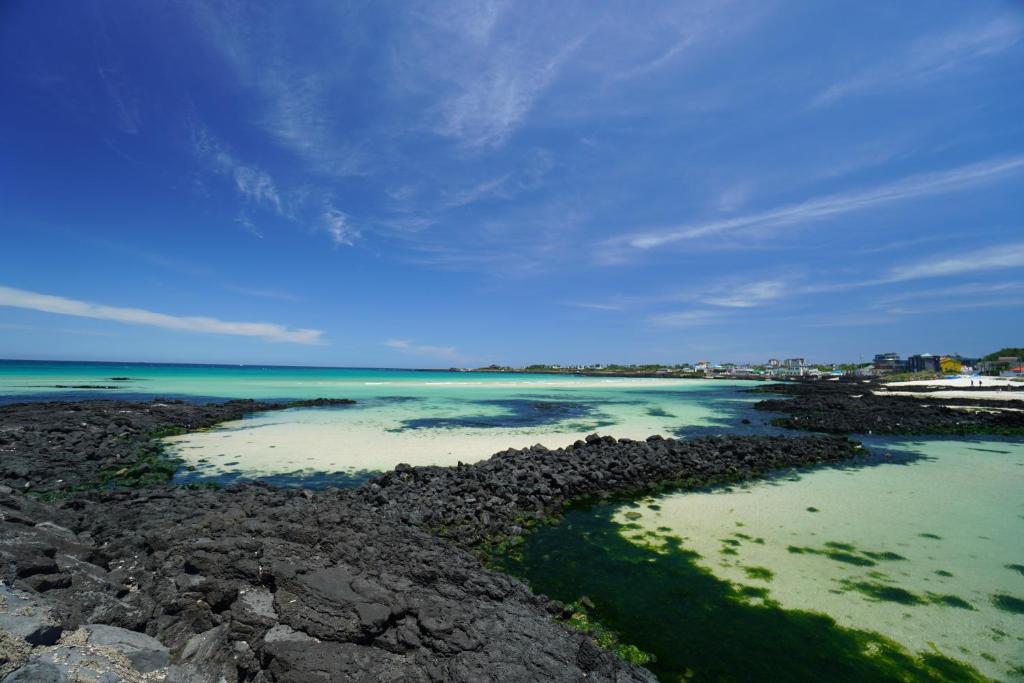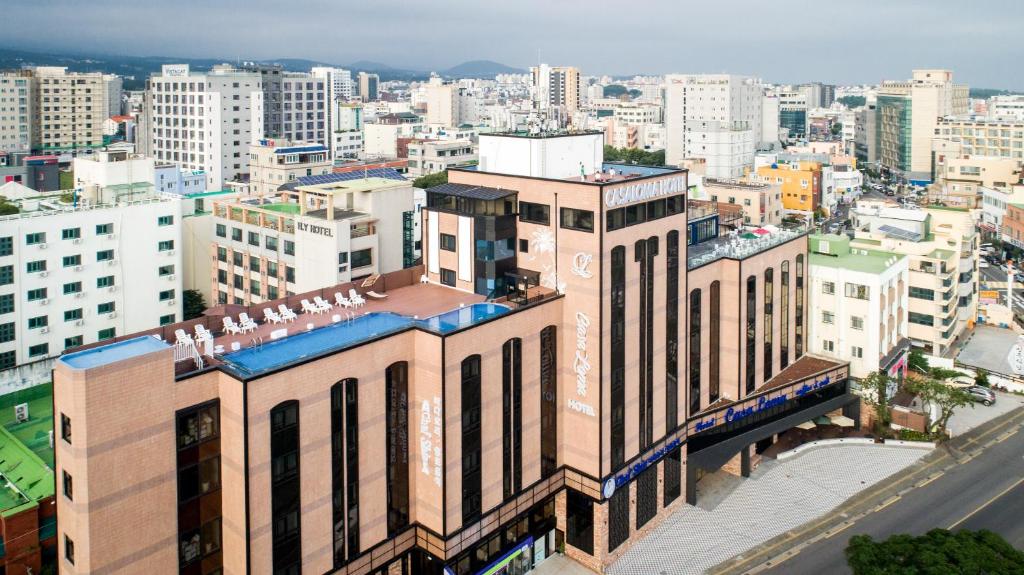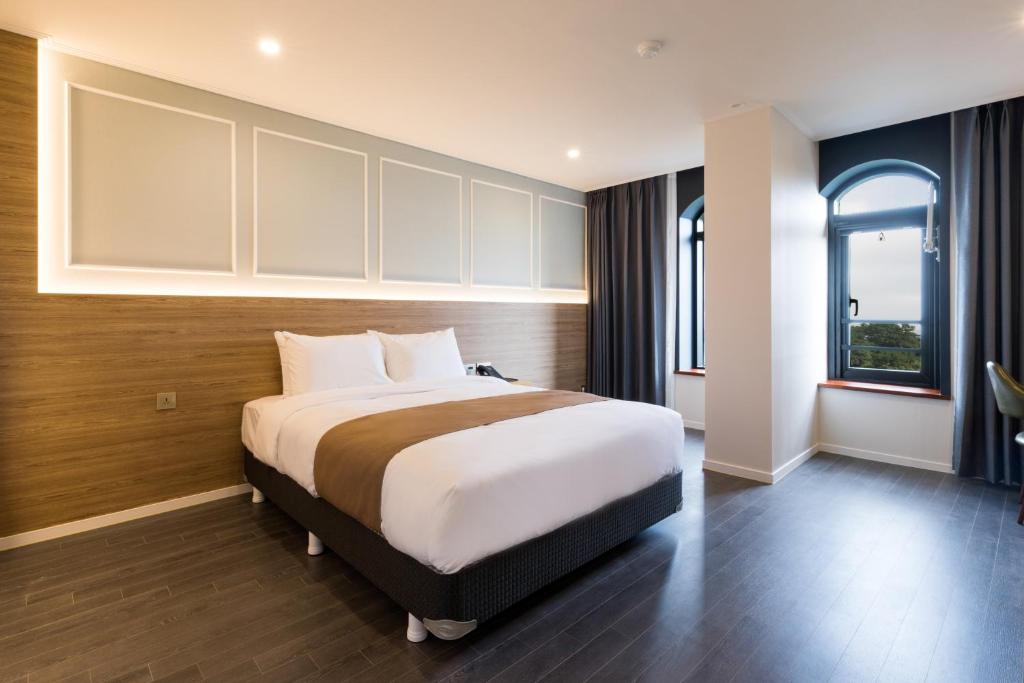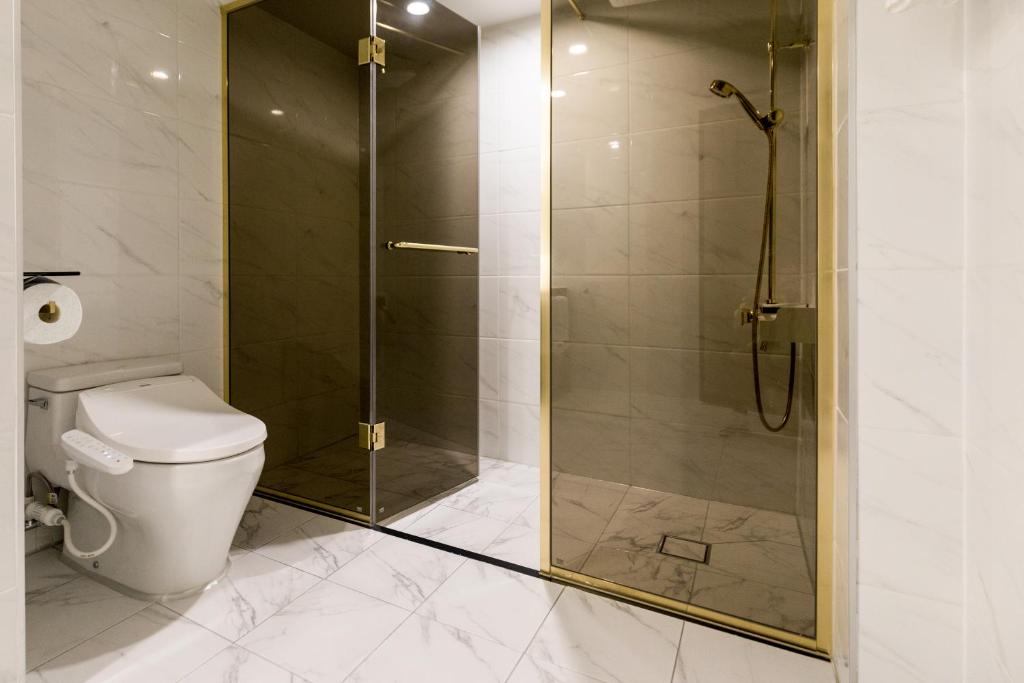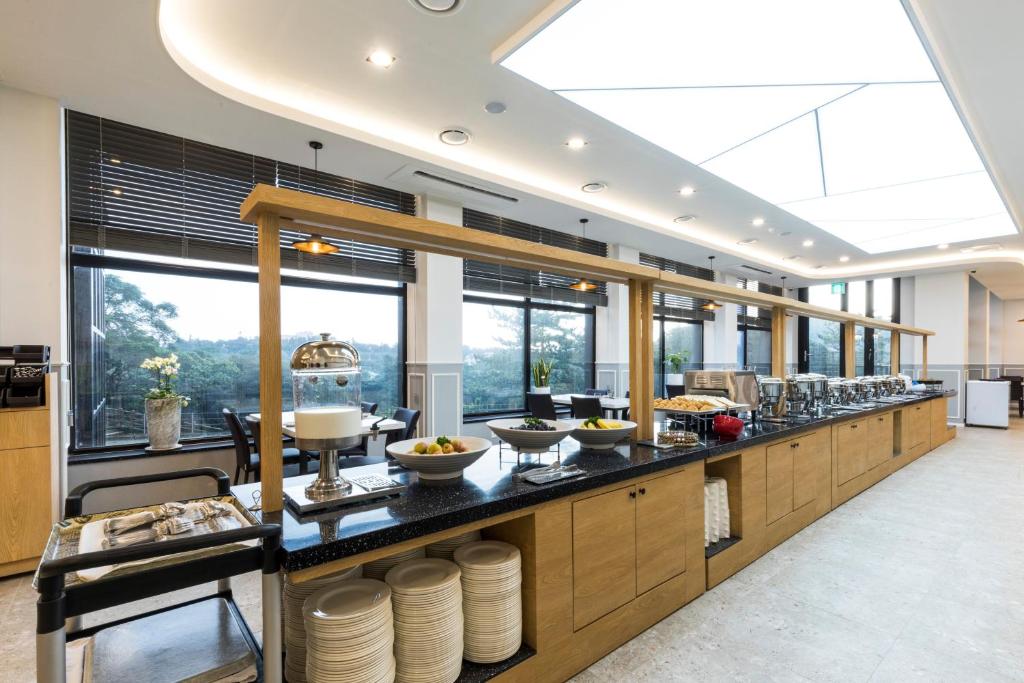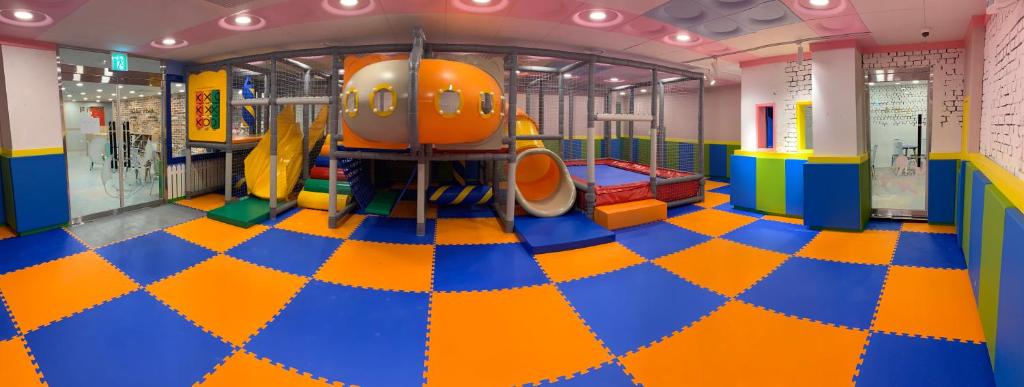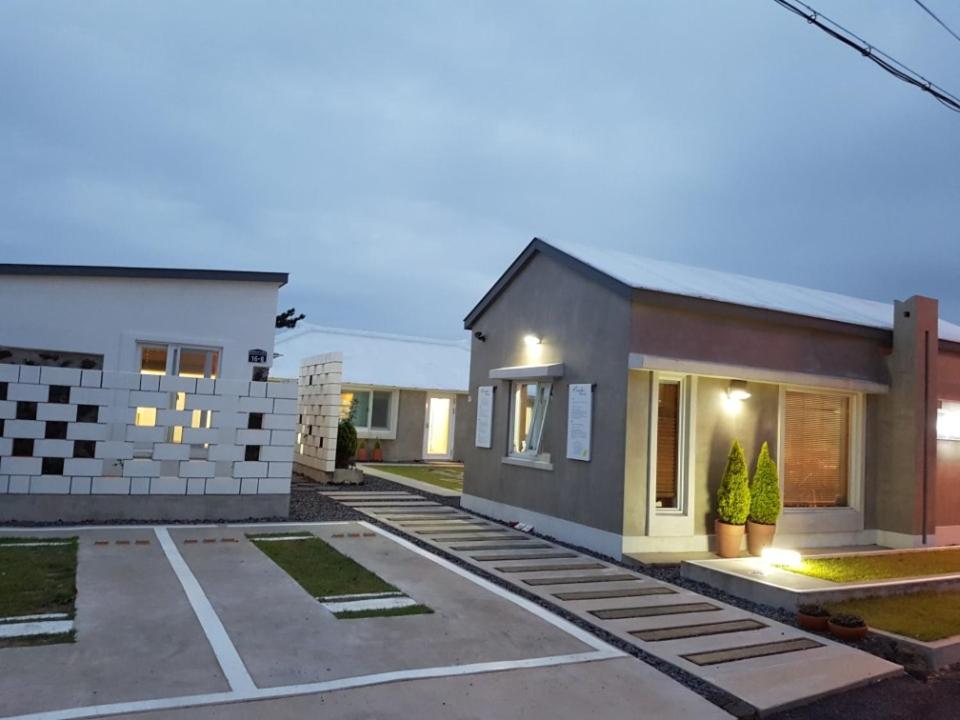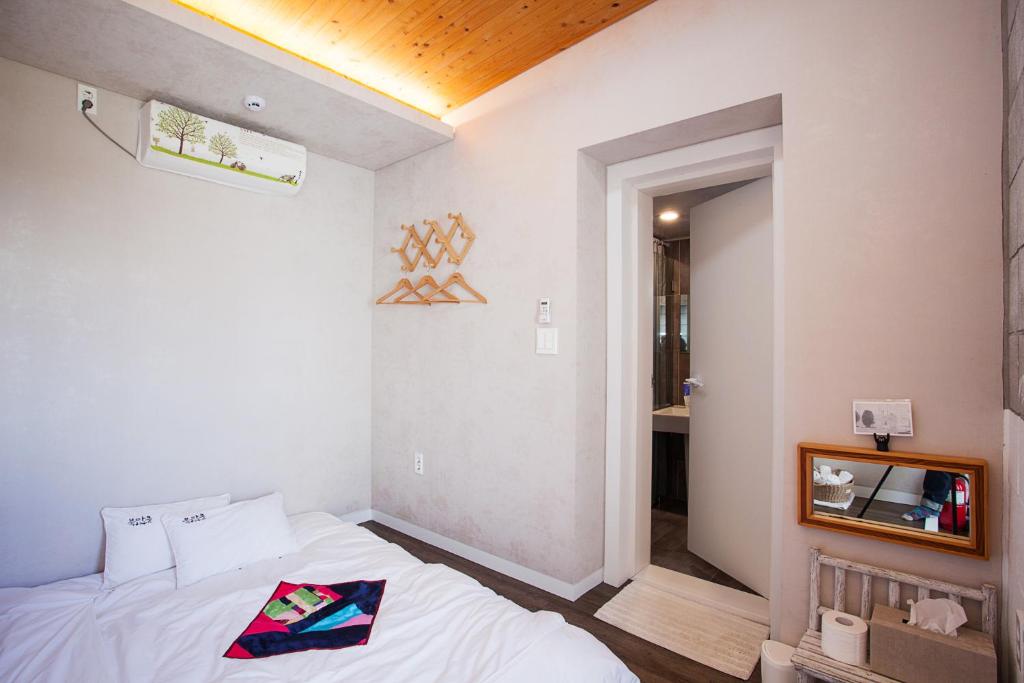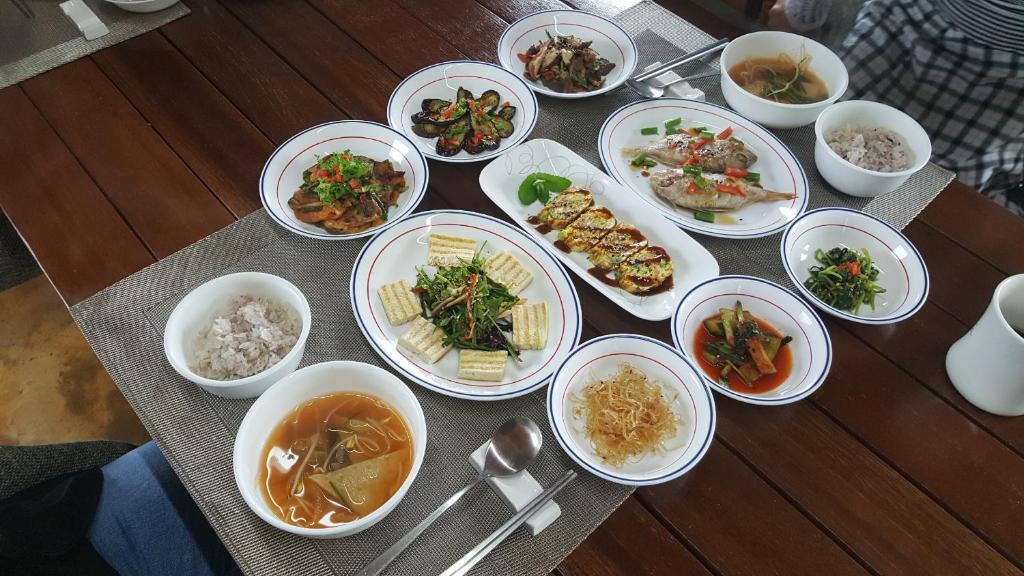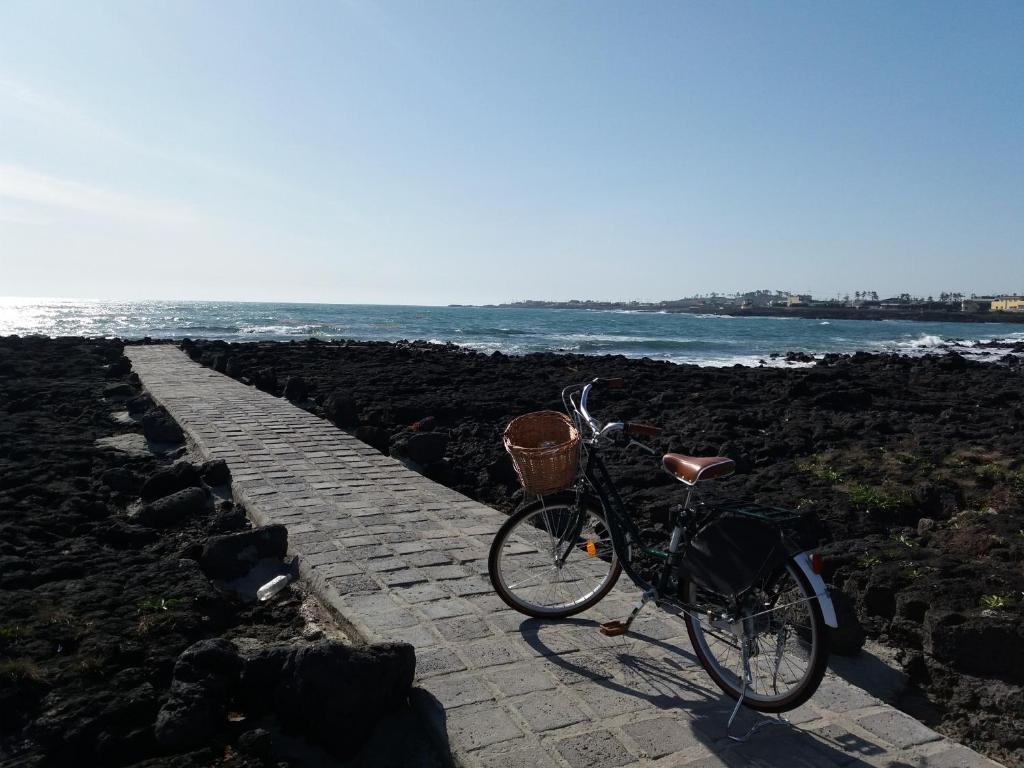Jeju island is Korea’s largest island located off the southern coast. It is roughly one hour by plane, and one of the most popular vacation destinations in South Korea. The island offers beautiful landscapes, beaches, and a very unique culture. It is called the “Hawaii of South Korea” for a reason.
Day 5
- Arriving at the Airport from Seoul at 13.55
- Pick up rental car at the airport at 15.00
Jeju City
The main focus of this day will thus be on exploring Jeju City and its surrounding area, since this is also where the airport is located. Since we only arrive in the afternoon, it is unclear how much we can still do on this day. Thus, below you can find some suggestions to do and we will pick as many as we can fit in one day. These selections do not include any of the many museum options, from the national museum of Jeju to contemporary art museums.
Dongnum Market
This market is Jeju’s largest and oldest traditional market. In this market, you can eat fresh sea food, but also shop for some knicknacks. There are many popular dishes that you can try here, as mentioned under the food section.
Dongnum Market
Sanjicheon Street
This street runs along the Dongnum Market. The stream that runs alongside the street is home to a lot of freshwater fish. Thus, in the summer it attracts a lot of anglers. Downstream of the street you can find the port, which also displays a restored Chinese sailing vessel.
Sanjicheon Stream
Black Pork Street
Chilseong road is a street in the old part of Jeju city. In this street, you can find a wide range of restaurants that serve black pork, but for more of that go to the food section. The street is located next to the sea, so it is also pretty to take a stroll there.
Tapdong Plaza
This is a public space in Jeju city, with a lot of sporting places for kids to enjoy. It is located right next to the sea, so it has a nice view. The plaza often hosts various performances, and can be a relaxing spot for a sunset stroll.
Yongduam Rock
On the northern part of the city, surrounded by nice cafés you can find Yongduam Rock, also known as Dragon Head Rock. It is a 10 meter tall rock that is worn down by strong winds and waves, leading to the rock looking like a dragon’s head. There are many legends surrounding the rock. One legend has it that a dragon stealing precious jade from Hallasan Mountain was shot down by an arrow from the mountain deity. When he fell down, his body immediately sank into the ocean and his head rapidly froze looking at the sky. Another legend has it that a white horse, who dreamed of being a dragon and ascending to the sky, came to be caught by a soldier and froze into the rock.
Dragon Head Rock
Iho Tewoo Beach
This beach is close to downtown Jeju City. It has a mix of yellow and black sand, and has two horse-shaped lighthouses nearby. The beach is a good spot in summer, and might be worth a visit if time permits in the fall as well.
Ihe Tewoo Beach
Hamdeok Beach
Hamdeok Beach is considered one of the top three most beautiful beaches on Jeju Island. It is 20 km from the airport, so not super close to the city but nearby enough. The beach is known for its clear emerald-blue water, tall palm trees, and white sandy shores. However, this destination is considered the prettiest during the summer months.
Hamdeok Beach
Jeju Loveland
Jeju Loveland is a controversial outdoor theme park, that interprets sex through art. The entire park is a vast artistic space featuring a variety of works approached from perspectives of enjoyment and humor. At night, the park is beautifully illuminated with colorful and exotic lights, creating a mysterious ambiance. It has 140 sculptures of humans in various sex positions.
Jeju Loveland
Gwaneumsa Temple
The temple is located a little bit away from the city, 650 meter up the slope of the Hallasan mountain. The road to the temple is known to be very scenic, with a lot of trees and plants. The temple is a buddhist temple, containing a lot of significant structures. For more of a spiritual experience, visiting the temple could be a nice option.
Gwaneumsa Temple
Day 6
This day is dedicated to exploring the middle part of Jeju Island. This is mainly the Hallasan National Park area.
Hallasan National Park
This day will be dedicated to climb the Hallasan Mountain, the highest mountain in South Korea. The mountain is a 1950 meter high shield volcano, located in the center of Jeju Island. It is considered one of the most breathtaking places in Jeju and thus also is included in the UNESCO World Heritage List. There are many trails on the mountain, but only two of them reach the top. The Seongpanak Trail, which is 9.6 kilometers long, takes about 4-5 hours to reach the summit. The other trail is the Gwaneumsa Trail, which is 8.7 kilometers long and takes about 5-6 hours to reach the top. The latter is considered the more difficult trail. Most of the time hikers go up one of the trails and down the other, making it a full day hike. Thus, we will be trying to get tickets (yes you need to get tickets well in advance) for the Seongpanak Trail to then go down the Gwaneumsa Trail.
There are certain rules attached to the hike. For safety reasons, hikers need to be off the mountain before sunset. This means that the first stop, the mountain shelter, will close as 12.30. The mountain top will close at 14.00. Thus, we need to start our hike early in the morning, around 06.00-07.00 I would recommend. It will be tough, but the views from the top will be worth it.
There are also other smaller hiking trail options if you are not fit enough to climb the mountain. The Eoseungsaengak and Eorimok trails are a popular choice, offering a shorter and less strenuous hike with beautiful views. They are only 1.3km and take around 30 minutes. It provides nice view of the Jeju plains and Hallasan summit. The Yeongsil Trail is another paved trail option of 5.1km that takes 2.5 hours. It provides panorama view of green oreum (craters) and pinnacle rocks atop sheer cliffs. Donnaeko trail is a 7km, 3.5 hour trail that provides coastal views of Seogwipo and runs through a red pine forest. Seokgul-am trail is a short 1.5km, 50 minutes, trail. It does however include some steep steps. These various trails can also be combined together.
These trails will take up most of the day, but if there is some time left, here are two suggestions that are on the way to the next hotel.
Sangumburi crater
- Closes at 17.00
This crater is a flat crater 650 meters wide and 100 meters deep. The circumference is 2070 meters. There is a variety of wildelife in this crater, and is because of this also an interested place for researchers. The crater is said to be most beautiful during the fall due to gold colored silvergrass.
Jeju Stone Park
- Closes at 18.00
Jeju Stone Park is a unique park that showcases the volcanic rock formations of Jeju Island. The park features various sculptures and installations made from the island’s distinctive black basalt stone. Visitors can explore the park’s walking paths, enjoy the beautiful landscapes, and learn about the geological history of the area. It is actually really big and includes a museum with lots of exhibitions.
Jeju Stone Park
Day 7
Day 7 will be located on the eastern part of the island. This day is mostly dedicated to the Haenyeo, the female divers of Jeju Island. There are also some great nature spots in this area.
Haenyeo
Haenyeo are female divers in Jeju Island who have been recognized for their unique culture and way of life. They traditionally dive without breathing apparatus to gather seafood, and their skills have been passed down through generations. Their job can actually be quite dangerous.
Haenyeo Museum
First thing in the morning, we will go to the museum dedicated to the haenyeo women. The haenyeo have been recognized as UNESCO Intangible Cultural Heritage of Humanity. This museum was developed in 2016 to preserve and promote the culture of the haenyeo. It covers the history and culture of the haenyeo dating back to ancient times. It is a must-visit for anyone interested in learning about the unique traditions of Jeju Island.
Seongsan Ilchulbong
Then we drive to Seongsan Ilchulbong, also known as Sunrise Peak. Here between at 13.30 and at 15.00 the haenyeo perform their traditional diving skills, showcasing their unique techniques. Afterwards you have the oppurtunity to eat their freshly caught seafood at their restaurant. To arrive here, you need to look for Sea Women Restaurant or House of Women Diver. Besides the haenyeo, Seongsan Ichulbong is a beautiful volcanic cone that offers stunning views of the surrounding landscape. Thus an hike/walk around the area is also recommended.
Nature
Udo Island
- 15 minutes by ferry from Jeju Island
- Probably good to rent bikes
- Visiting this island while also wanting to experience the Haenyeo can be a tight schedule.
Udo Island literally means Cow Island, because the island is said to look like a cow lying down when viewed from Jeju. The island is one of Jeju’s most popular destinations, with 2.23 million visitors in 2016. It is known for its scenic beaches, sheer rocky cliffs, and sea caves. The island is famous for its peanuts and garlic, and you can try a peanut ice cream here. The island is also relatively flat, and mostly used for agriculture, but the coast can be rocky with sharp cliffs. There is a beach with black volcanic sand, as well as a lighthouse park.
Udo Island
Majanggul Lava tube
A lava tube is a type of lava cave formed when a low-viscosity lava flow develops a continuous and hard crust, which thickens and forms a roof above the still-flowing lava stream. This lava tube system, which stretches 7400 meters, is one of the largest lava tubes in the world. However, only 1 kilometer of the tube is open to the public. Inside the cave, you can see various lava formations, including stalactites, stalagmites, and lava columns. The 7.6 meter tall stone pillar at the end of the open section is recorded to be the largest in the world.
Majanggul Lava Tube
Bijarim forest
Bijarim forest is classified as a natural monument. Its 448165 squared meters of land is home to 2800 bija trees ranging from 500 to 800 years old. These majestic trees range from 7-14 meters in height, 50-110 centimeters in diameter, and 10-15 meters in crown width, so this forest is quite a rare example of its kind in the world. The berries of bija trees were used widely as a medicine used to kill parasites, while the wood was used to make premium furniture and go boards.
Bijarim Forest
Seopjikoji
Seopjikoji gets its name from its shape, jutting out to sea, with ‘koji’ being the Jeju dialect for a cape. Seopjikoji is a scenic area located on the eastern coast of Jeju Island. It is known for its beautiful coastal views, unique rock formations, and vibrant wildflowers. On top of the hill stands a beacon fire station, reaching 4 meters in height with a diameter of 9 meters, built using volcanic rocks. Behind the beacon fire station is Bulgeunoreum Volcanic Cone, vibrant with red soil. The white lighthouse atop the cone stands out in contrast. Seopjikoji has been used as a filming site for many Korean movies and dramas.
Seopjikoji
Folk Villages
Jeju Island is home to several traditional folk villages that offer a glimpse into the island’s rich cultural heritage. These villages feature well-preserved thatched-roof houses, traditional crafts, and local cuisine. Visitors can explore the villages, interact with local artisans, and learn about the island’s history and customs.
Jeju Folk Village
Jeju Folk Village reproduces the life in Jeju of the 19th century. More than 100 traditional houses have been recreated and exhibited in this village. It includes exhibition halls, model houses, and traditional folk games that visitors can interact with.
Seongeup Folk Village
Seongeup Folk Village is another village that preserves the living site of old Jeju, but here actual people still live. This is quite a difference from the Jeju Folk village, and it seems to me that this village is a little bit more “authentic”.
Seongeup Folk Village
Day 8
This day is again dedicated to the nature of Jeju Island, but now more focused on the souther region.
Waterfalls
Day 8 will take place in Seogwipo, the second largest city on Jeju Island, and its surroundings.
This area contains a lot of beautiful waterfalls.
Very close to the city, you can find the Cheonjiyeon, which lights up at night, and Jeongbang waterfalls.
A little bit further from the city there is the Eongtto waterfalls and the Cheonjeyeon waterfalls.
There are more waterfalls in Jeju and in this area, but these seem to be the most popular ones.
Cheonjiyeon Waterfall
Beaches and cliffs
There are 4 beaches/cliffsides closeby that might be worth visiting. The first one is the Daepo Jusangjeolli Cliffs. This is a stone pillar cliff formed by lava that flowed out of the crater and contracted when it coolled rapidly. It is staircase-shaped, with stones of 30 to 40 meters high, quite an impressive sight. The second one is actually a beach, the Jungnum Saekdalhaebyeon Beach. This beach has a white sandy beach, and is surrounded by volcanic rocks. It is a prime surfing location due to the frequent winds and high waves. A lot of international surfing competitions are held there. The thirds is the Baksugijeong Beach/Cliffs. This one is already less beach-like due to the lack of a typical sandy shore. It is more of a rocky beach, and is located next to some pretty cliffs. The last one is the Yongmeori Coast. This one is probably the coolest, since it is a hydrovolcano rocky shore formed by the accumulation of volcanic debris erupted from three craters under the sea. he coastal cliffs look like a dragon’s head (‘Yongmeori’) due to long periods of sedimentation and erosion. The oddly shaped cliffs created by the waves provide a magnificent scene.
Sort of related, but not quite the same, there is also the Oedolgae Sea Stack. This is a 20 meter high rock pillar located on the coast, formed by wind and waves eroding the surrounding rock. It is estimated to have been formed 1.5 million years ago.
Daepo Jusangjeolli Cliffs
Tangerines
Jeju is famous for its tangerines, which are a must-try when visiting the island. You can find many tangerine farms where you can pick your own fruit or buy fresh tangerines. This is especially taking place during the winter months, so from November until February. Bong Bong Tangerine farm seems to be pretty close to Seogwipo, and according to a Reddit user very popular with locals. On the other hand, Hallabong Experience Farm is a little bit further away, but seems to be one of the more popular spots. Close to Seogwipo, there is also a citrus museum if you want to learn more about the history and cultivation of tangerines on the island. The museum also includes tangerine harvesting.
Tangerine Farm
Maeil Olle Market
This is the largest market in Seogwipo. It formed in the early 1960s and now stretches 620 meters in length. To get some fresh food, this might be a good spot. The nearby streets can also be traversed to take in more of the city and the local culture.
Yakcheonsa Temple
This is one of the biggest Buddhist temple in whole Asia. Originally a small hermitage named Yaksuam, it was named Yakcheonsa because of a famous mineral spring (‘Yaksu’) nearby. It enshrines tombstones of two royal couples from the Joseon Dynasty: King Munjong and his consort, and King Yeongchin and his consort. It contains the largest wooden Buddhist statue in Korea.
Yakcheonsa Temple
Day 9
Day 9, the last day on Jeju, will take us to the western part of Jeju island. This includes some beaches and other activities.
Tea and Skin Care
Close to each other on Jeju island, you can find the Osulloc Tea Museum and the Innisfree Jeju House.
Osulloc Tea Museum
The tea museum is located in the vast organic tea farm and showcases the rich history of Korean tea within this beautiful setting. Originally, the area was impossible to grow any kind of crop because of the rocks. However, Osulloc had cultivated the farm and now it has become the most extensive organic tea farm in Korea. The Hallasan mountain helps in this process, since it creates lots of clouds and fogs that creates a shading effect that improves the color of the leaves.
Innisfree Jeju House
Innisfree is a natural brand that embodies the natural beauty of clean Jeju Island. It is a very popular Korean skincare brand that uses natural ingredients from Jeju Island in its products. Since it is manufactured in Jeju, you are able to buy their products and a reduced price here.
More Beaches
One of the more popular beaches in Jeju is the Hyeopjae Beach. It has smooth white sand, shallow waters, and a gentle sloop ideal for swimming. Of course this last part is less important in the colder months. However, it is also encircled by a lush pine forest and has a stunning view of Biyangdo Island, making it still worthwhile to go during the colder months. Hyeopjae Beach extends seamlessly into Geumneung Beach, which is another beautiful spot worth visiting. It has a lot of the same features as Hyeopjae, but is a little bit less crowded. If you really want to see more beaches, you can also still visit Gwakji beach. It has a long stretch of white sand and clear blue water. It is also mainly nice for swimming.
Hyeopjae Beach
Hyeopjae Lava Tube
This cave, similar to the Manjanggul Lava Tube, is a fascinating natural formation created by volcanic activity. The cave is approximately 200 meters in length, 10 meters in width and 5 meters in height. It is thought to have been created by the lava that erupted from Hallasan Mountain some 25 million years ago. This cave uniquely contains features of both lava and limestone caves. The entire area surrounding the cave is a huge stratum of seashells and sand, while the interior of the cave has a mystical ambience due to its various formations such as stalactites and stalagmites, hanging from the ceiling and sprouting up from the bottom of the cave. The cave also features pillars formed when stalactites and stalagmites join together. The cave walls are covered in lime, which at times looks like beautiful cave paintings.
Hyeopjae Lava Tube
- Hand in the car at LOTTE rent-a-car Jeju airport at 18.00
- Take the plane at 20.10 to go to Busan.
- From Busan continue on the next day to our Temple Stay at Haeinsa Temple.
Accommodations
Jeju is known to be not easy to travel around. It is only an island of 80 kilometers in length and 40 kilometers in width. However, the speed limit on the island is 50 kilometers per hour, which does not make it easy to get around quickly. We thus decided to stay at different locations to make the most of our time. This also gives us a chance to experience different aspects of the island.
Hotel Nanta Jeju
- Day 5-6
- Check-in from 14.00, check-out before 11.00
- Address: 56-26, Seondolmokdong-gil, 63242 Jeju, South Korea
This hotel is chosen because it is one of the hotels closest to Hallasan Mountain. And since we want to start early with our hike, I thought it is probably best to be located as close as possible. The hotel seemed luxurious enough, no other considerations were really taken into account. However, there does seem to be quite a bit going on, like a fitness center and a live-performance theatre. We booked two standard twin rooms.
Hotel Nanta Jeju
Hotel Armor
- Day 6-7
- Check-in from between 15.00 and 22.00, check-out before between 06.00 and 11.00
- Address: 2060-20, Haemajihaean-ro, Gujwa-eup, Gujwa, 63364 Jeju, South Korea
There were not a lot of hotels in the east of Jeju Island, or at least not many that met our requirements. One of them being breakfast options and being close to the Haenyeo Museum. However, we did find Hotel Amor, which had both. The hotel is really close to the beach, which might be even more ideal in the summer. It also has an outdoor play area and mini golf, so it seems like an ideal place for children. We booked one deluxe double room and one standard twin room. However, the hotel is not available on booking, so I am not sure what the rooms look like anymore. You will have to see when I actually visit.
Hotel Amor
Casaloma Hotel
- Day 7-8
- Check-in between 16.00 and 22.00, check-out before 11.00
- Address: 347, Taepyeong-ro, Seogwipo-si, Jeju-do, Republic of Korea, Seogwipo City, 63592 Seogwipo, South Korea
Casaloma hotel is located in Seogwipo. It is a four-star hotel that even has a pool, but I do not think it is open during winter months. It has a roof terrace with a great view, a fitness center, and a lot more facilities. It also has lots of activities for chilren if you have any. Overall, the hotel looks quite fancy, but we could book it for a reasonable price due to an early booking discount. We booked two superior double rooms.
Casaloma Hotel
Bookmark Guesthouse
- Day 8-9
- Check-in between 16.00 and 22.00, check-out before 11.00
- Address: 16-8, Ilgwadaesu-ro 11beon-gil, Daejeong-eup, Daejeong, 63504 Seogwipo, South Korea
Our last accommodation is the Bookmark Guesthouse. This is a small guesthouse located in a small village close to the sea on the western side of the island. Compared to most of our other accommodations, which are more western, this one is more simple. The beds are actually futons on the floor, which is quite common in traditional Korean guesthouses, however something we are not used to. We will have to see how that goes. The main reason for choosing this guesthouse is its raving reviews about the breakfast. On the pictures the food also looks amazing. A breakfast more traditional Korean style is definitely something we want to try. We booked two standard double rooms.
Bookmark Guesthouse
Food
Black pigs are a special breed of domesticated pigs in Jeju. Thus, black pork is one of the island’s most famous dishes. This can be specifically tried on the black pork street in Jeju City.
Since we are going in November, we should definitely eat some tangerines, maybe even tangerines picked by ourselves. Hallabong Oranges are also a signature fruit of Jeju Island, known for their unique shape and sweet flavor. There are also various Hallabong desserts to try.
In general, Jeju is known for its fresh seafood. This makes sense for an island. We should definitely try some seafood dishes, especially at the local seafood markets and restaurants. I think it is especially nice to eat fresh seafood at the Haenyeo restaurant near the Seongsan Ilchulbong (Sunrise Peak). This way we can taste the freshly caught seafood by these amazing women.
